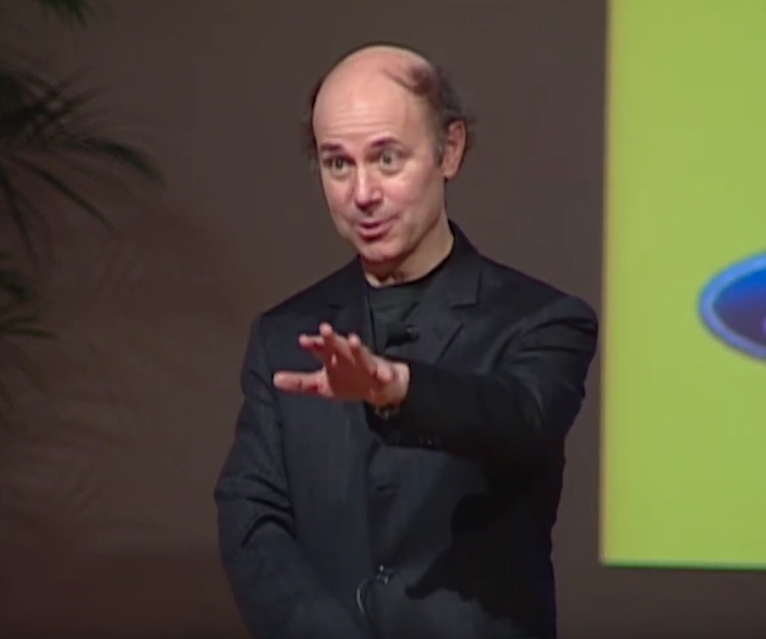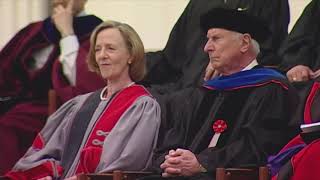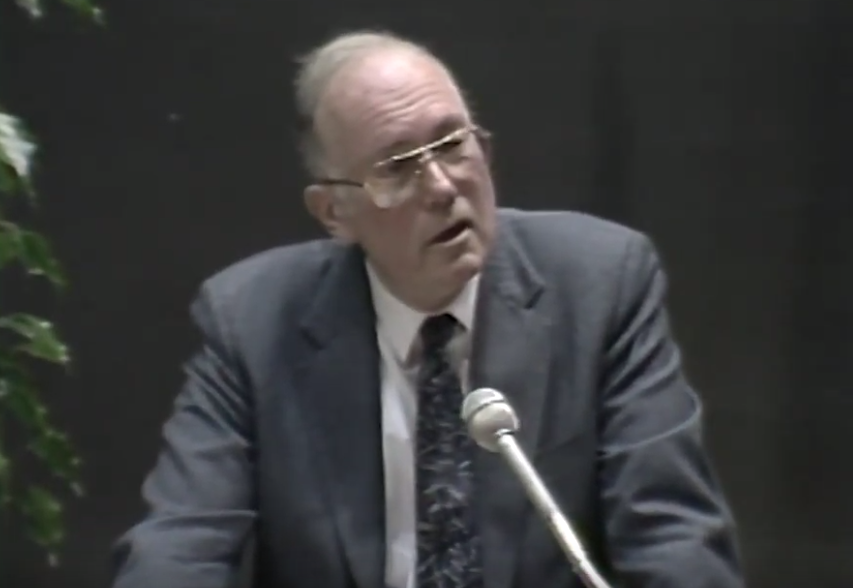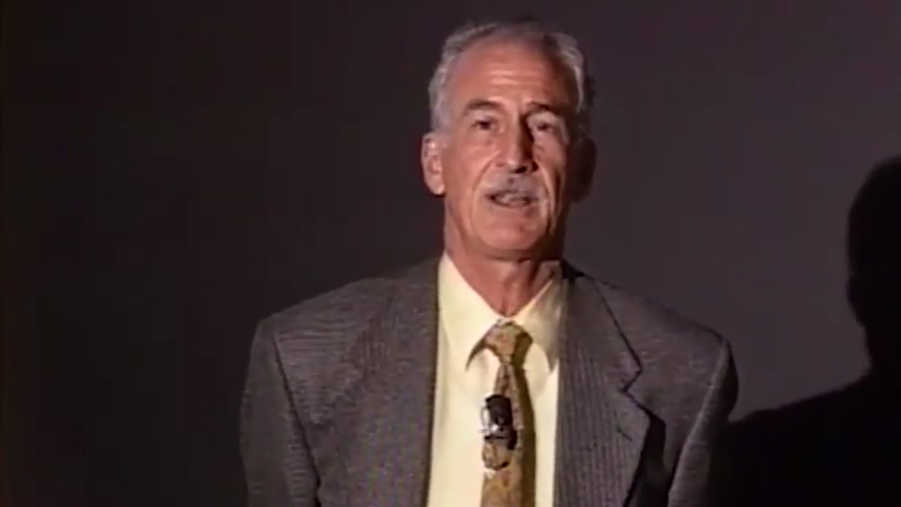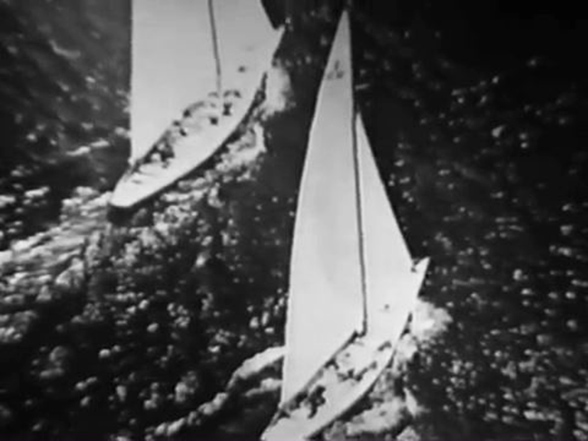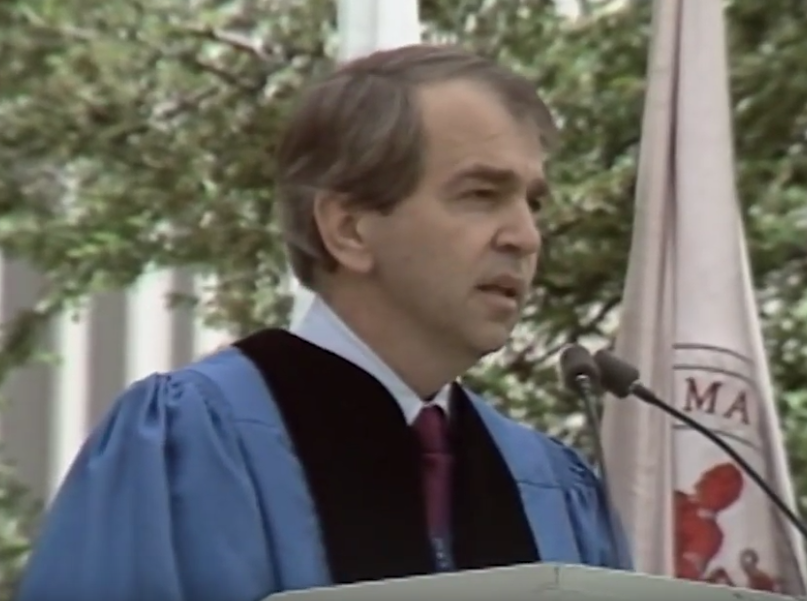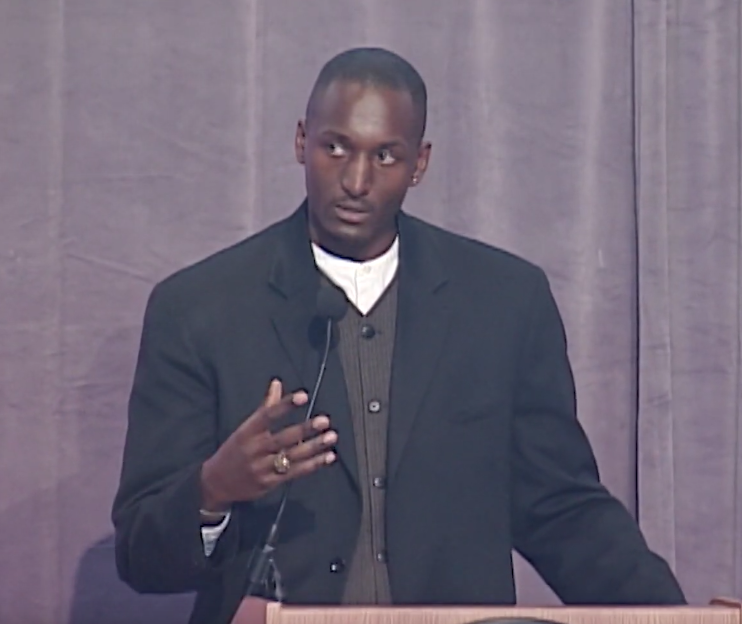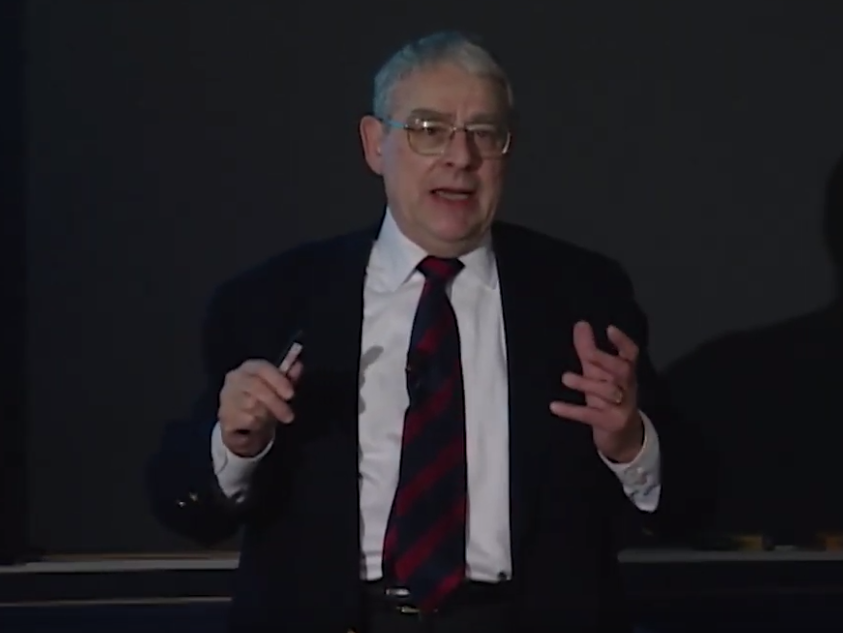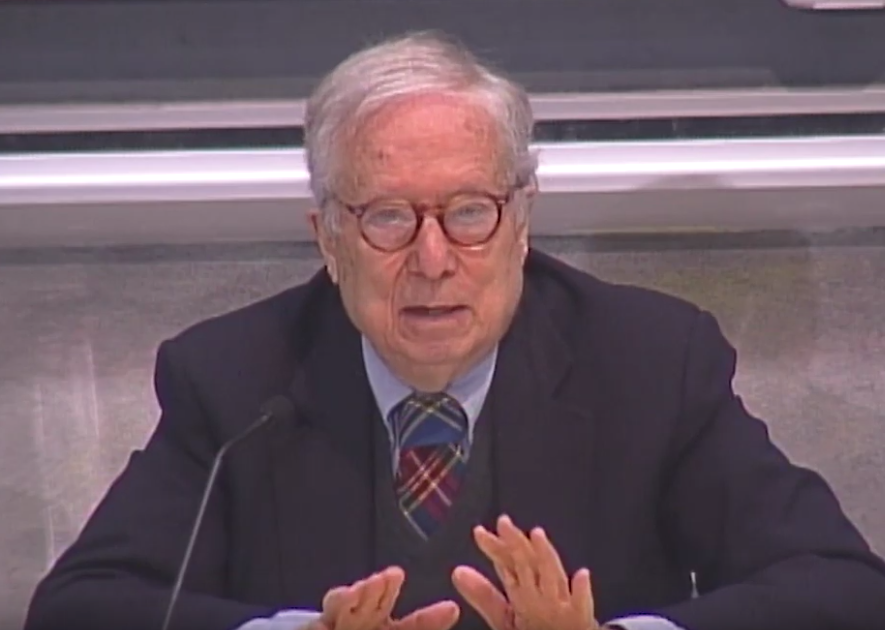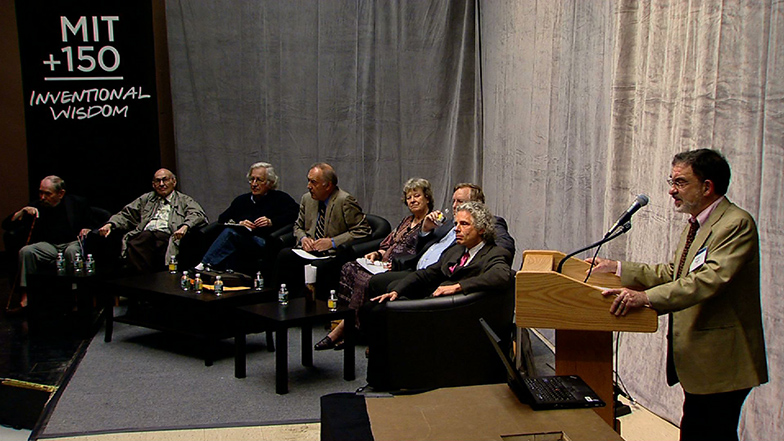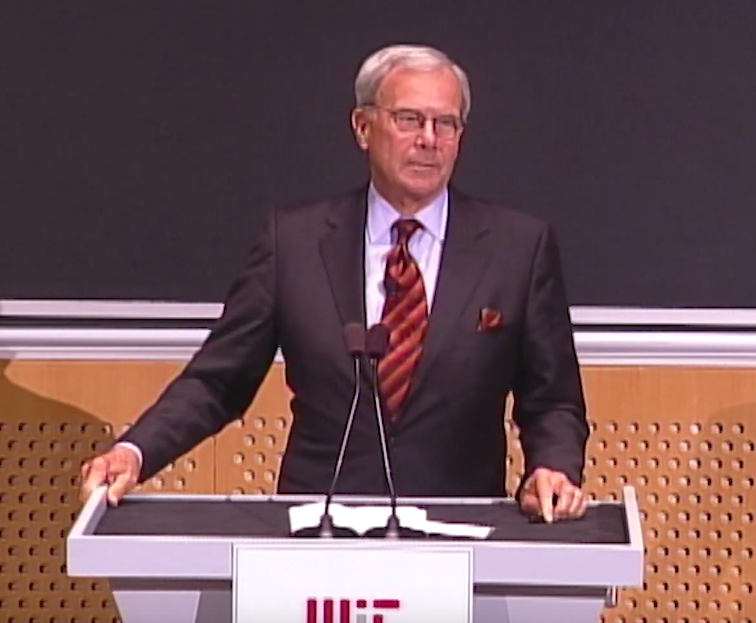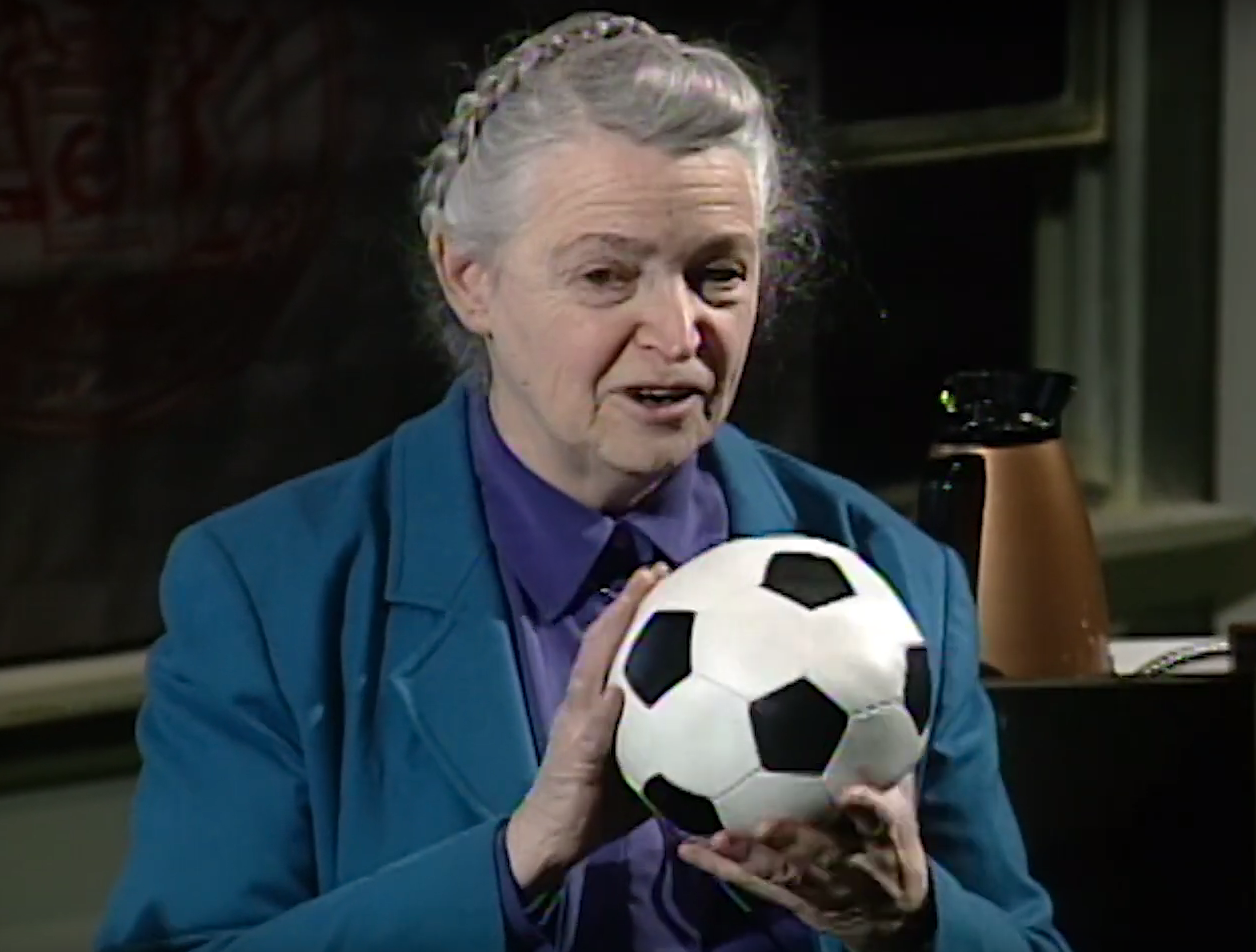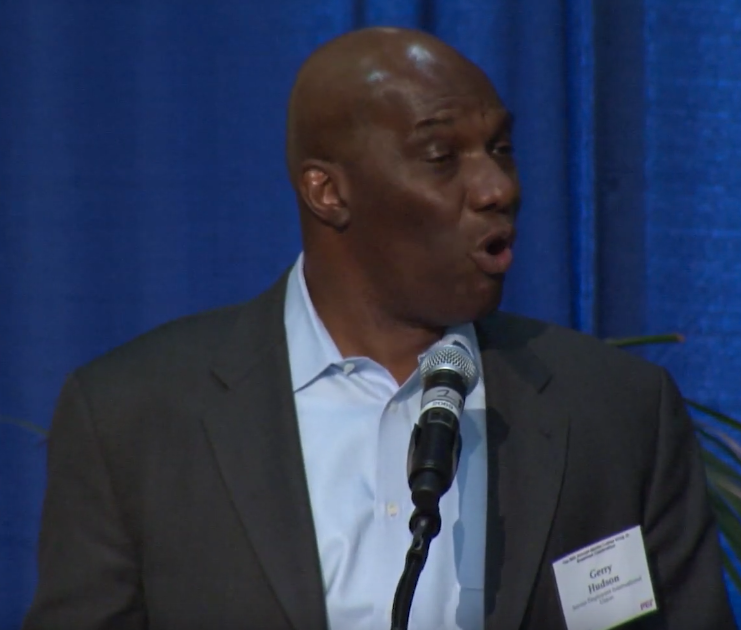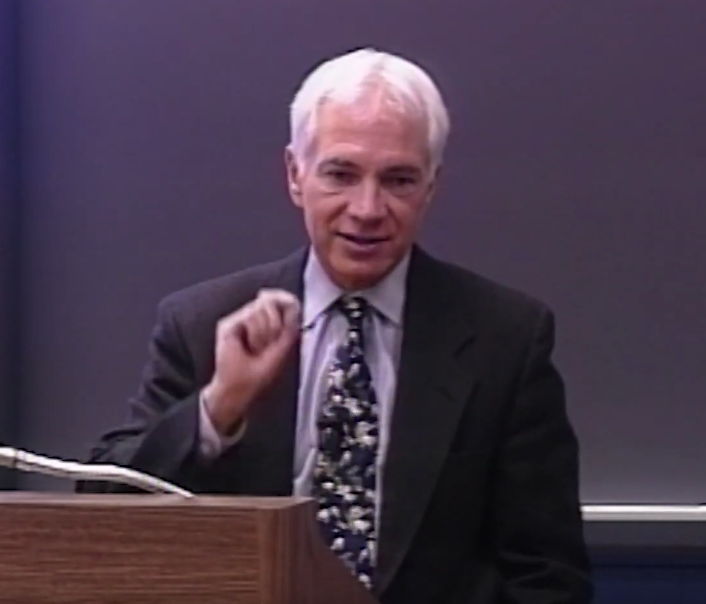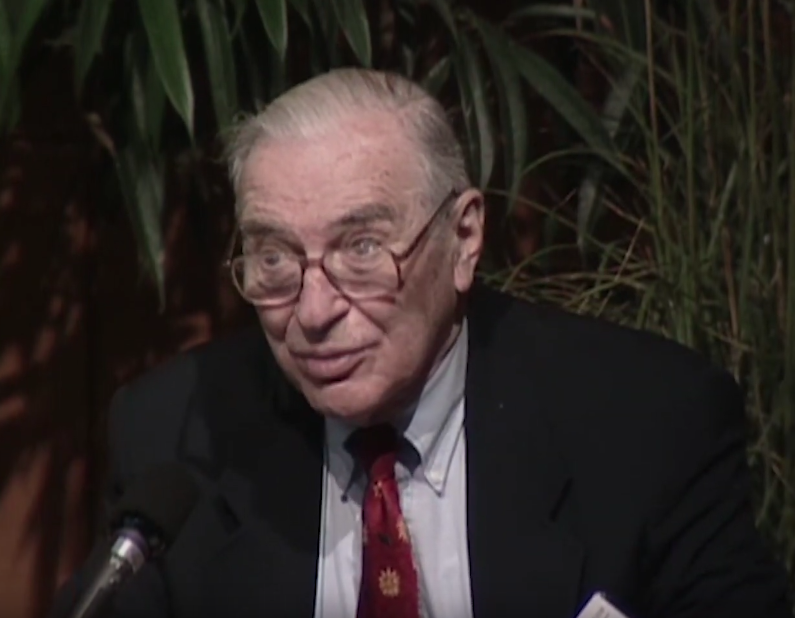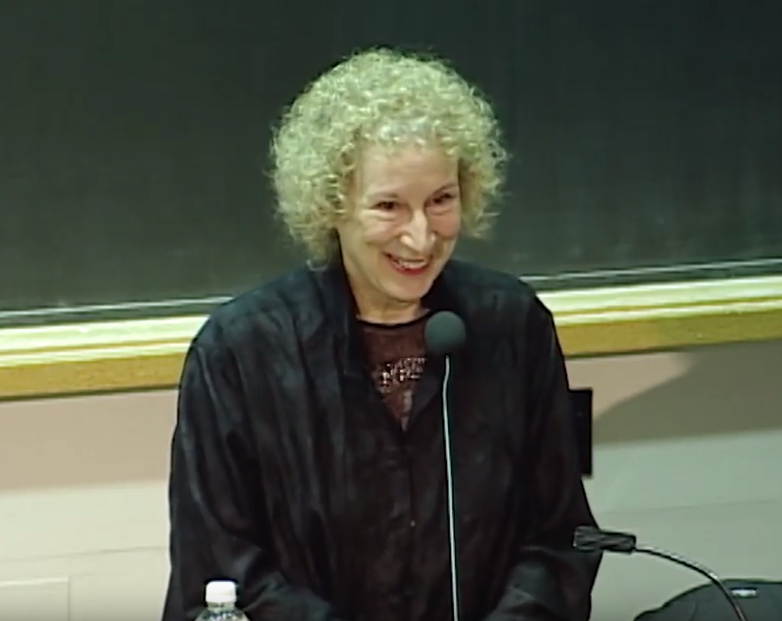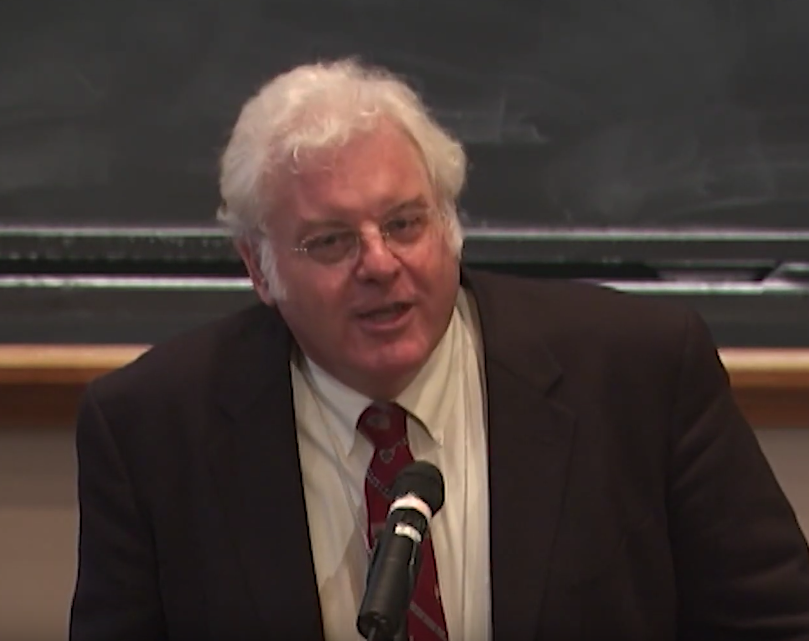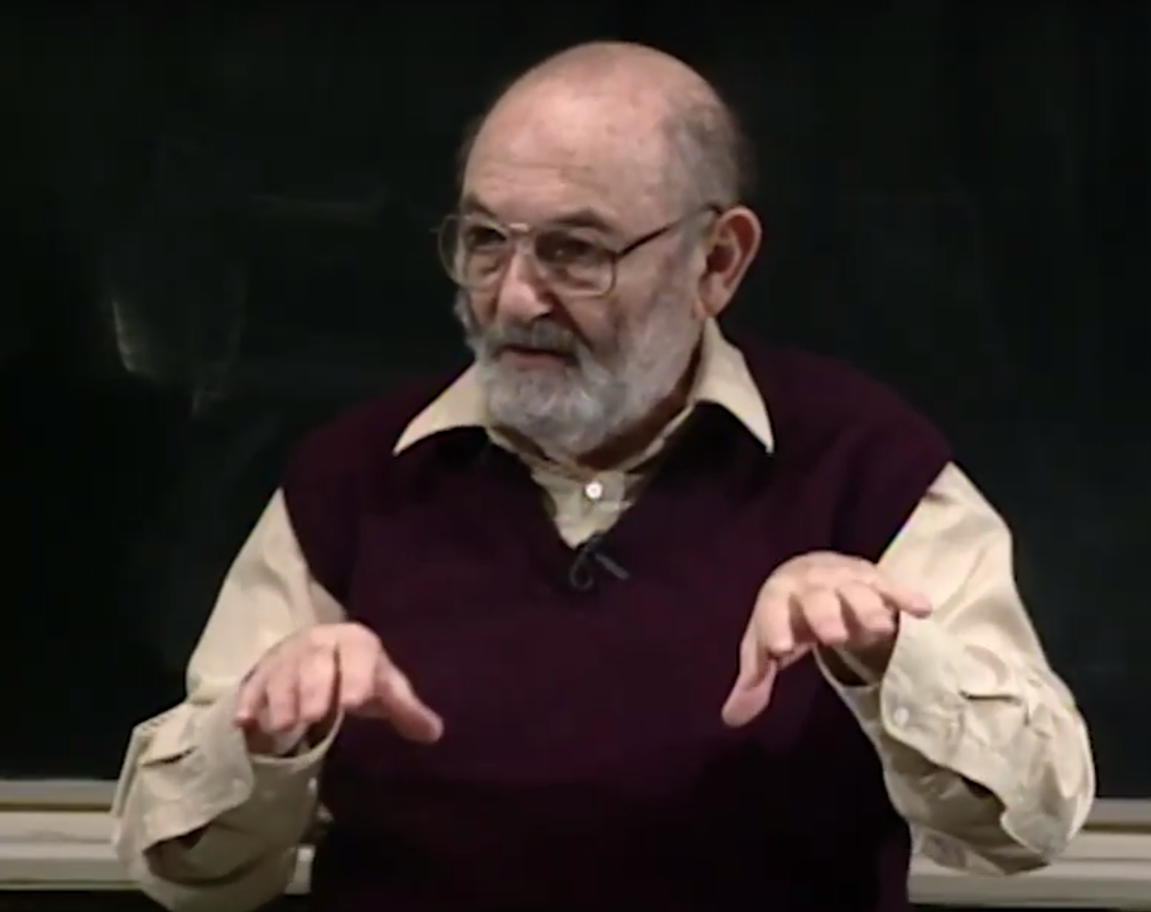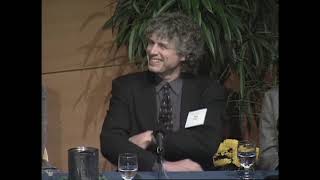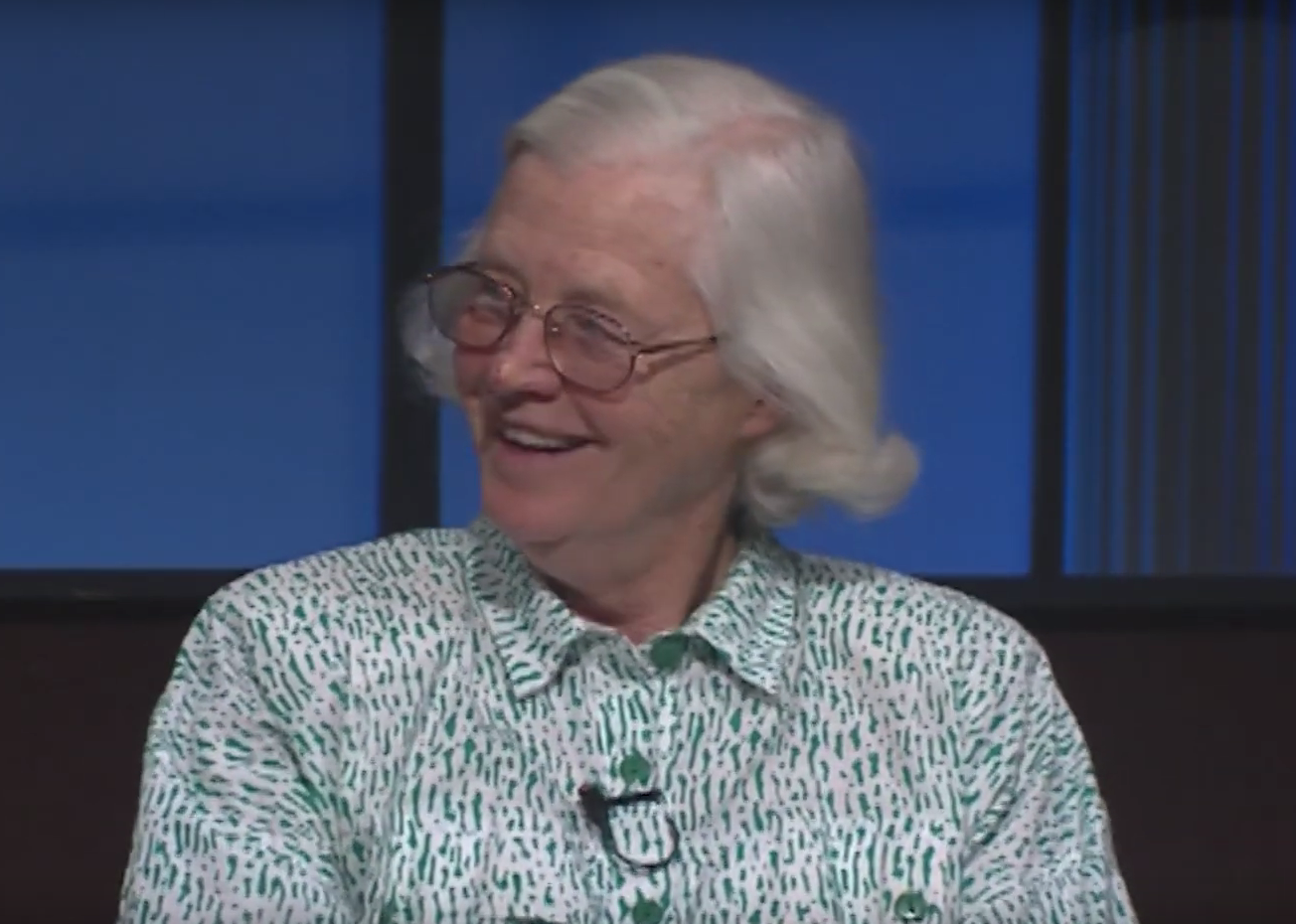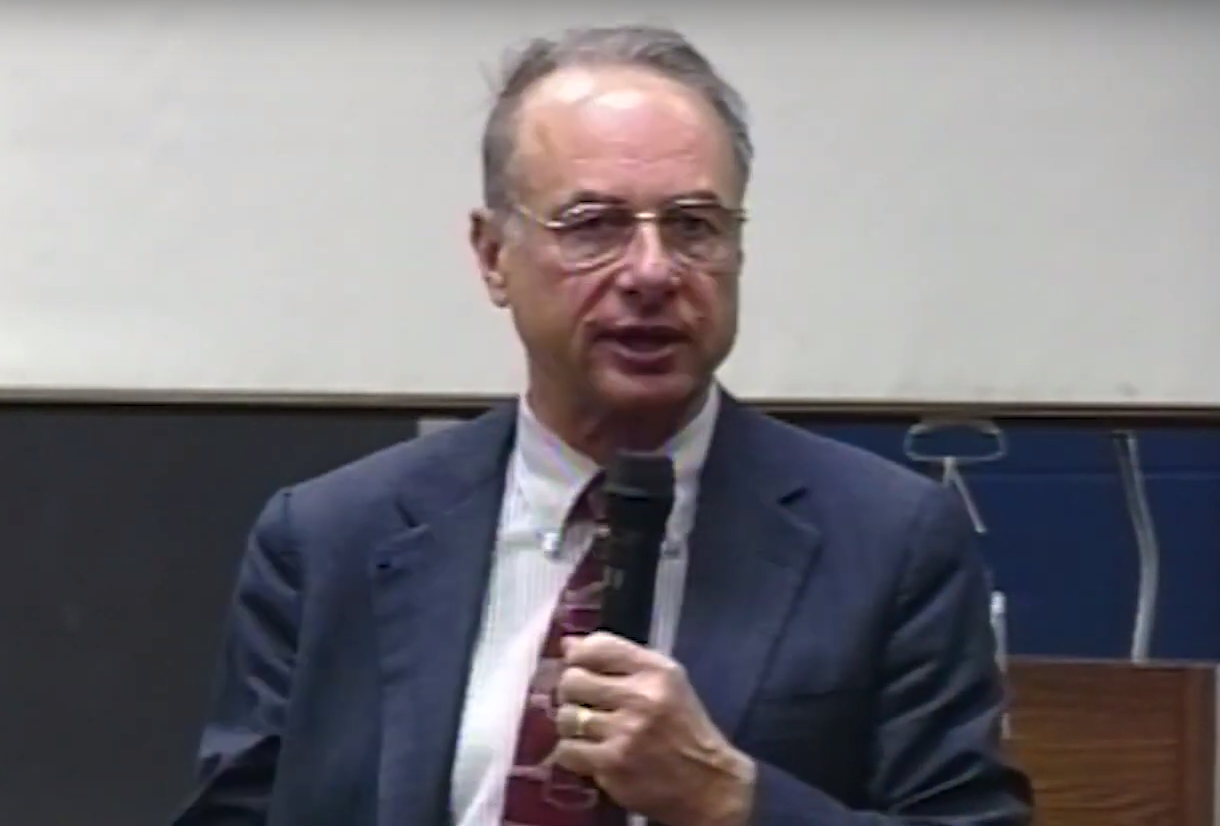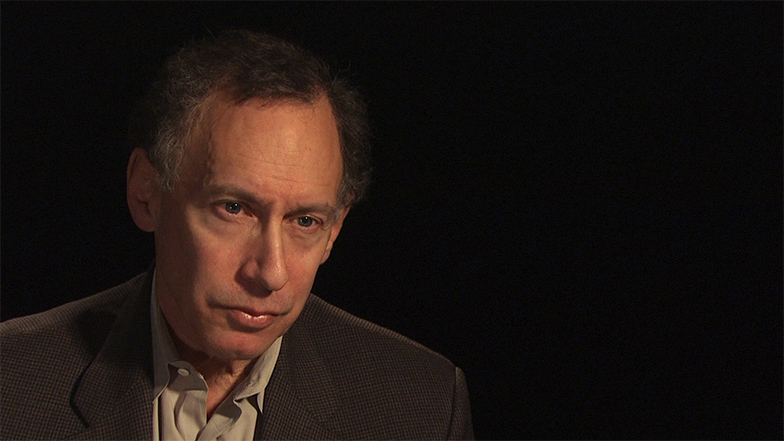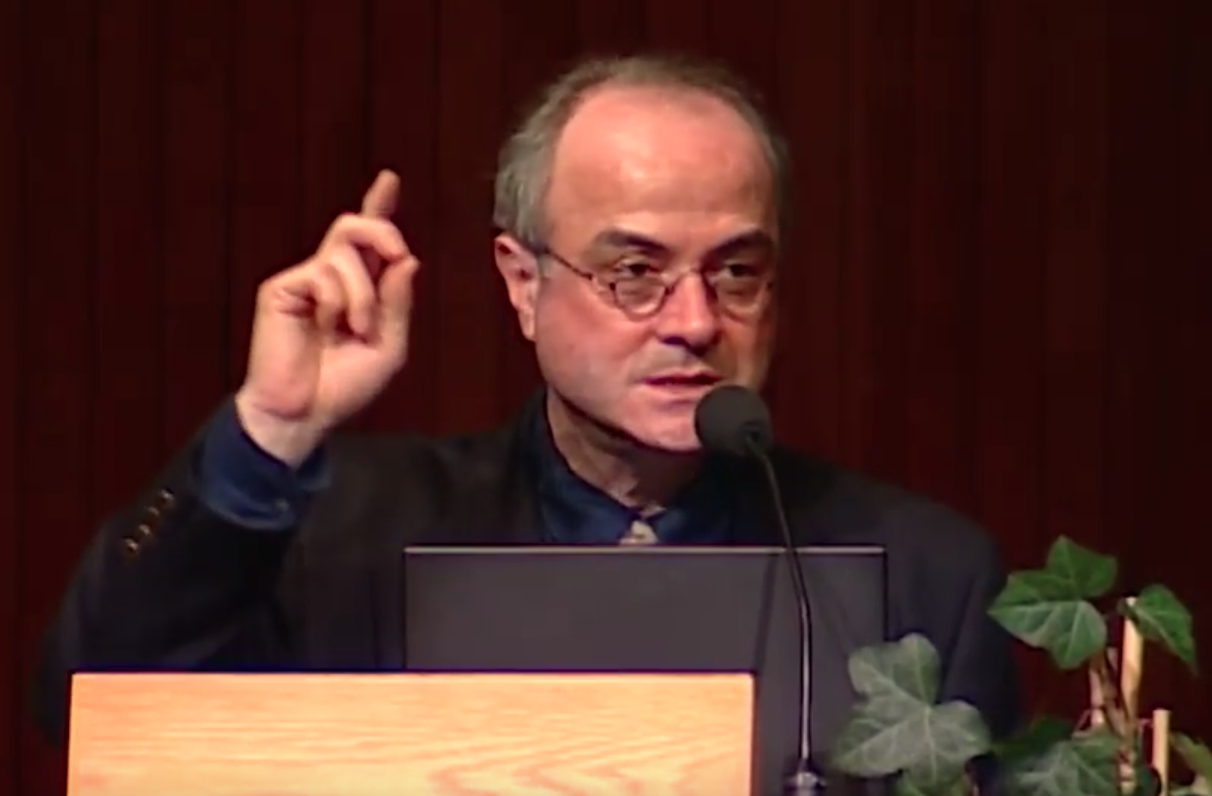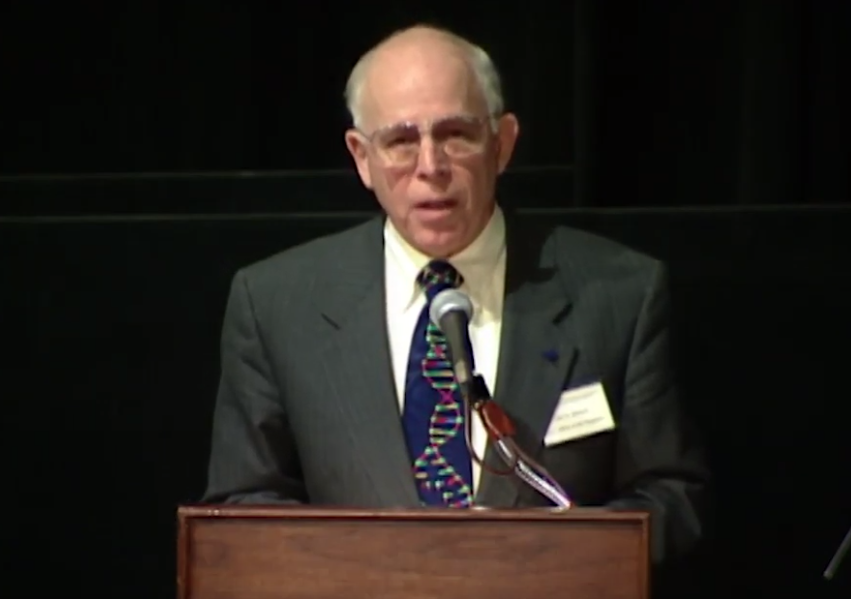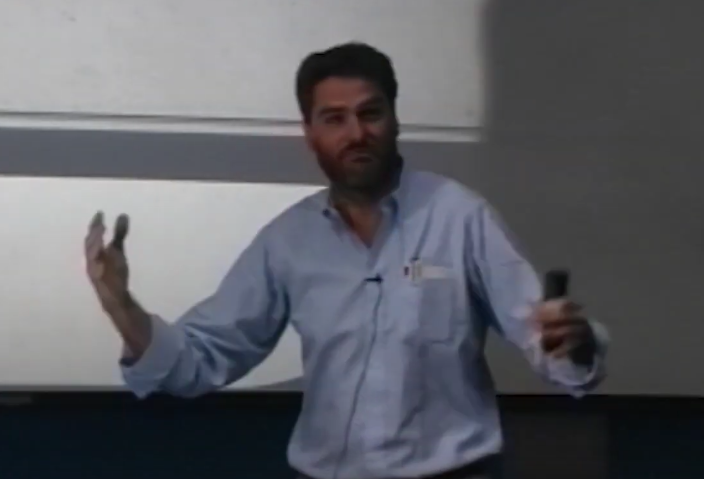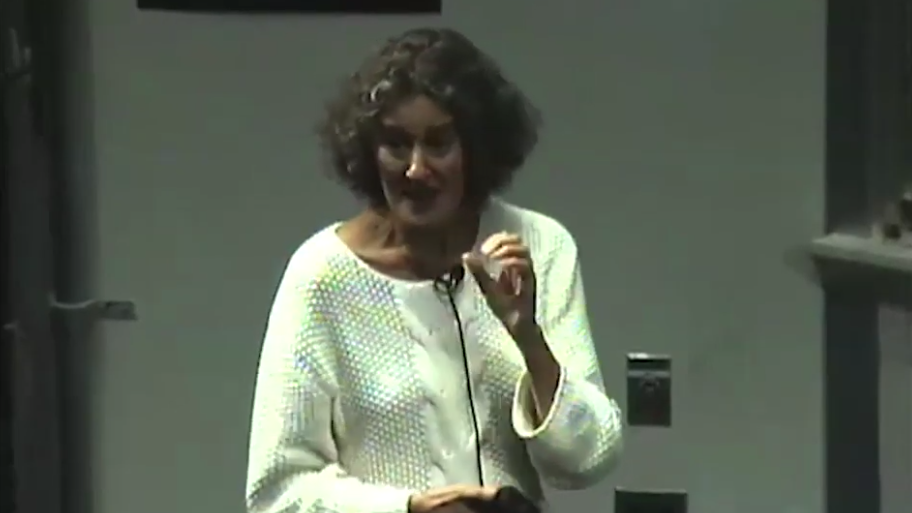Technology Day 2001—"Origins and Beyond: Our Place in the Cosmos"
HECHT: One of my faculty colleagues says you can tell the kind of class you're in by the response. If it's an undergraduate class, there's no response. They're still asleep. If it's a group of adults, you get that kind of shout back. If it's a group of his graduate students, they write down the words, good morning.
[LAUGHTER]
For the two or three of you who don't know me, I'm Bill Hecht. And for the last 21 years, it's been my privilege to be your executive vice president. Now, I have done this for 21 years. But four times during that time are very special to me because I'm a 1, and most of you are 6's or 1's. So for the best bunch of people, the 6's and 1's, congratulate yourselves.
[APPLAUSE]
There is a small secret which I'll share, which is not a happy thought, actually. I discovered not too many years after I took this job that statistically I was rapidly becoming an older alumnus. I tried to deny that for many years. But as you can see by the ribbon, this is our 40th. So I can't deny it much anymore.
Welcome to Saturday classes. Those of you who are youngsters don't understand that this used to happen every Saturday morning. And we went usually to lab on Saturday morning and worked very hard over experiments, which we were all convinced that Michelson and Morley lied, that Millikan had oil in his glasses, not in his oil-drop experiment. But suffice it to say, we all survived. And that's part of what MIT is about, surviving in style.
It's my great privilege this morning to introduce you to yet another spectacular Technology Day program. I must tell you a little secret. For 21 years, at the end of this program we say, how in God's name are we going to equal this year, never mind be better? And each year, the volunteers and my staff, with the great collaboration of this unusual and rare and extraordinary faculty, seem to do better.
So it's my great privilege to start the morning proceedings by introducing my good friend, Chuck Vest, President of MIT.
[APPLAUSE]
VEST: Thank you, Bill, very much. And good morning to all of you. Welcome back to Cambridge. I think that we all know that universities study and learn from the past. They have some level of engagement in the future-- in the present. And they have something vaguely to do with the future.
What really sets MIT apart from most institutions, in my view, is while certainly we respect and indeed try to learn a bit from the past, we are really, among universities, very deeply engaged in the present and, above all, really working very hard to invent the future.
And another characteristic, I think, of this institution is that we tend to be involved with big, important things and to ask big, important questions. Well, today, we are going to tune this very slightly, and we're going to take a look really into the very distant past, as well as the present and the future. And we certainly are not going to shy away from big questions.
The program for today's event was inspired by this highly characteristic painting by Paul Gauguin, tropical paradise graced by stately figures who somehow manage to look simultaneously moody and serene. I've seen those expressions around this campus from time to time.
[LAUGHTER]
But there's much more going on here than in Gauguin's customary renderings of Polynesian life, because he chose to use this panel to pose some of the eternal questions in its title. Where do we come from? What are we? Where are we going?
So you'll notice that while Gauguin asks these questions brilliantly, his painting is very careful not to actually provide the answers. It's a time-honored technique, though perhaps more typically reserved for use on mid-term exams.
[LAUGHTER]
And of course, these are questions that genuinely resist being answered in any simple or final or even definitive way. But today, we're going to try anyway, this being MIT. This morning, we'll hear from four outstanding scientists who will share insights from their own lifelong pursuit of great answers about origins, the origins of our universe, our solar system, and, in a sense, of ourselves.
This afternoon, three separate panels will give us a chance to look down the road toward some thrilling new frontiers-- what we are learning about the development of mind, language, vision, and understanding, some startling new materials and technologies that will transform our lives, and the latest reports from the realm of exploration from the depths of the ocean to outer space.
Gauguin, of course, was not the only artist to consider fundamental questions of our existence. For the class that just graduated yesterday, the class of 2001, inevitably Stanley Kubrick's film 2001 has been sort of a mascot over the last four years. And in fact, that film has become such a cultural icon that it's hard to remember that it itself was based on Arthur C. Clarke's wonderful book.
But we've kind of forgotten what it was really all about. Because for all of its billing as a space odyssey, I think the deepest lesson is that the simple truth that some of the most important, undiscovered territories are to be found within us in the mysterious recesses of our own hearts and minds.
This morning, we're going to examine both ends of this spectrum of inquiry, from the sources of our universe and our planets, to the origins of humankind, right down to the level of our own genome. These are exciting times for discovery. And today promises to reflect that excitement. We're going to begin by hearing from Eric Lander, followed by Claude Canizares. We will then take a brief break, following which we will hear from Maria Zuber.
Stephen Jay Gould is unfortunately not able to be with us as planned this morning, but he has asked us to let you know that he very deeply regrets not being with us. However, we are really very fortunate to be joined by one of Steven's colleagues, Charles R. Marshall. Charles will speak after Maria. Professor Marshall, we are extremely grateful for your willingness to join us on such exceedingly short notice. And just to-- since this is MIT we'll quantify short notice. He's down putting his slides in the tray right now.
[LAUGHTER]
Following Professor Marshall's remarks, we'll have a period for question and answer back and forth between the audience and our speakers. Let me begin by introducing the first two speakers, those who will speak prior to the break. Eric Lander is professor of biology here at MIT and a member of the Whitehead Institute for Biomedical Research.
He's the director of the Whitehead/MIT Center for Genome Research, which, as you may know, was the largest single contributor to the Human Genome Project. Last February, that project published a draft sequence and initial analysis of the human genome, the set of DNA-encoded instructions that define an individual person.
Before Eric begins, I want to tell you that we have something here at MIT called Campus Preview Weekend. This is a weekend in which we invite all the young men and women who have been admitted to MIT but have not yet declared what university they will attend. And we had here in Kresge this spring a panel of MIT students so that the prospective students could ask them questions.
And one of the first questions-- one of these bright high school students held up her hand and said, can you people somehow characterize what's it like to be at MIT? What's good, what's bad? And a hand immediately shot up and said, the defining moment of my time here at MIT was when Eric Lander spoke to us all in room 10-250 about the final publication of the sequence of the human genome. That really characterized what this place is all about, and I think we would all agree with that.
Our second speaker this morning is Claude Canizares, Bruno Rossi Professor of Experimental Physics at MIT and Director of the Center for Space Research. Claude is also Associate Director of NASA's Chandra X-ray Observatory Center and leads the development of Chandra's high-energy transmission-grading spectrometer, just one of his many space astronomy missions.
While Eric is, in a sense, an expert on inner space, Claude's focus is clearly on the far reaches of outer space. He's a specialist in both X-ray and optical astronomy, meaning that he studies stars, galaxies, clusters of galaxies, quasars, and other things which give us important clues to the structure, evolution history of the universe. We begin with Eric Lander.
[APPLAUSE]
LANDER: Thanks very much, Chuck. Well, welcome to this day about origins and beyond. I'm going to start us off by talking about a variety of kinds of biological origins, origins of life, origins of human populations, origins of cancers, all of which our knowledge about emerges from the work of the Human Genome Project over the course of the last 10 years.
There's another important origin that runs throughout all of what I'm going to say, which is that the origin of an awful lot of the Human Genome Project and the data that's come out of it is here at MIT. MIT is woven completely into all of this project, both the intellectual ideas that got it started, the tremendous amount of work that got it done, and particularly the multi-disciplinary approaches involving biology, computer science, and engineering, that made it possible for it to happen here in a way that I think it couldn't have happened any place else.
So let's talk about origins. For thousands of years, humans have recognized the tremendous diversity in our own species and in the species around us. This is my favorite picture to illustrate diversity, Wilt Chamberlain and Willie Shoemaker here, showing the wonderful diversity in our own species with respect to height and weight and skin color.
And to me, it's also emblematic of the differences that you don't see, in differences of susceptibility to diabetes and hypertension and cancer, all of which are underlain by the action of genes working together with environment.
But of course, for thousands and thousands of years, we could do little more than say that traits tended to transmit in families, and we really didn't understand the origin of this transmission. Well, the major breakthrough, historically, was the work of Gregor Mendel in 1865 when he published his one great classic paper indicating that there were these abstract particles that he could infer called genes that were transmitted according to specific laws of inheritance, in crosses.
Now, as you may or may not know, Gregor Mendel's paper is a wonderful paper, but it sank like a stone. It had no impact on the world at all because the world just wasn't ready for it. Mendel, perhaps somewhat discouraged, really never wrote much more about genetics and, in fact, went into administration. And that's pretty much the last--
[LAUGHTER]
He became the abbot of the monastery.
[LAUGHTER]
In any case, the real revolution of genetics dates from about 35 years later, in the opening weeks of the 20th century. In January of the year 1900, three independent groups around the world rediscovered Mendel's laws, so to speak. They went back, and they started doing crosses. They began to see these regularities. And then they pulled out this paper and recognized what its tremendous importance was. And so the 20th century started with a bang with the understanding that there were laws that somehow controlled traits.
The first quarter of the 20th century was spent pinning down those laws to a cellular structure. By about 1925, we had a pretty good handle that the cellular origin of these abstract laws were in the chromosomes. Of course, we didn't have a clue what the chromosomes did.
Chromosome, just the word "chromosome" itself is a tribute to the scientific ability to cover up ignorance with a fancy name. The only thing that was really known about the structure of chromosomes then was that they picked up a dye when you stained the cells. And so they were called chromosomes, meaning colored things.
[LAUGHTER]
It took another 25 years to work out what these colored things really were. And by mid-century, we were able to determine that the chromosomes had, as their molecular basis, the DNA double helix, the work of Watson and Crick, this iconic double-helical image with information running on one strand and a redundant copy on the other strand. Of course, this didn't tell us how, in an information theory sense, heredity was encoded in this polymer.
But the next 25 years was spent working out the genetic code, the understanding of how the sequence of bases encoded messages, which went off to little factories in the cell that turned them into proteins through a process of translation according to a genetic code, as well as the tools of recombinant DNA, including very prominently here in Cambridge. And these tools of recombinant DNA let us do what the cell does, that is to say, copy and read out particular pieces of DNA, and even to modify those pieces.
So we got to about 1975 now with an ability to read some DNA sequence. Well, the last quarter of a century has been a time of voracious appetite to read everything we can get our hands on. It started with the reading of individual genes here and there, then more and more genes, then small genomes, the entire collections of genes in an organism, to somewhat larger genomes, to, by the end of the 20th century, a first-pass reading of the entire genome of the human being at 3 billion letters.
It's not bad for a century, to have gone from a recognition of abstract laws to essentially a comprehensive read-out of the 3 billion letters underlying that. It's a pretty good century, although I think we ain't seen nothing yet.
In the last 10 years, 10 or 15 years of that century, it began to become clear that we could use this kind of information about genetic sequence to take a systematic approach to understanding disease. Now, all through the 20th century, people worked on disease, and in some cases, they were very lucky and were able to get to the basis of a disease.
But as you well know, luck is something you can't count on any particular day when you go into the lab. Far better would be to have a systematic approach that you could apply to every disease regardless of its type. Whether it was brain degeneration or bowel irritation, you would like to have a common approach.
Well, that approach was first laid out here at MIT in about 1980. The notion was a very simple notion, that if you traced the inheritance pattern of a disease in a family, you could see that the disease appeared to be transmitted according to Mendel's laws. And if you could just find a piece of DNA which had a spelling difference that seemed to have the same pattern of transmission, then, although that piece of DNA might not be the cause of the disease, well, it must lie fairly close by.
And that is indeed this notion of genetic mapping that was laid out for the human being around 1980 or so and became operational here in Cambridge in the mid-1980s. And it led to the identification of many, many particular disease genes. Once you've found a marker that was nearby, of course, you don't have the gene itself, what you have is a long work ahead of you.
In fact, you have to go through a very tedious process called chromosome walking, or more formally, although we don't call it in the literature, chromosomal schlepping, where you would start with the marker, and then you would schlep along the chromosome, because it's incredibly tedious using one piece of DNA to get the next piece, the next piece, the next piece, the next piece, the next piece. And then four years later and $40 million later, you might arrive at the gene of interest, say cystic fibrosis on human chromosome number 7.
Well, here's the sequence of the cystic fibrosis gene. It's got a lot of letters. It doesn't look very impressive. But I've boxed for you one particular little feature over there-- I better blow that up. There we go. Those three letters CTT, those three letters are deleted in the majority of chromosomes with cystic fibrosis. About 2%, 3% of the population will carry that particular deletion.
And in fact, on the way out the door, if we wanted to, everyone could spit in a test tube, and enough buccal cells would come off from the inside of your cheek to have enough DNA that we could just take it back across the street to the lab, amplify it, and tell you if you were a carrier for that deletion. You don't have cystic fibrosis unless you have a double dose, but we could tell you if you were a heterozygous carrier.
Well, not just that, not just DNA diagnostics emerge from that, but even more emerges. One can toss the sequence of the cystic fibrosis gene into a computer and ask the computer, ever seen anything like this before? And the computer says, oh, yeah, this looks an awful lot like dozens and dozens of genes whose products sit at the surface of the cell and transport things back and forth. Congratulations. You've just found a transporter.
Now this, of course, stood on its head the usual way of doing biology. The usual way is when you make a discovery, you go back to the lab, and you spend years and years trying to figure out what this gene does. Now you spend a couple of seconds hitting the Return button, and the computer, more often than not, comes back to you and tells you what your gene does because somebody somewhere else in the world in some other organism has studied something sufficiently similar that you have a pretty good guess.
That kind of hypothesis generation by connecting all of biological knowledge has led to a dramatic explosion of research. Because in the old days, all bits of biological research were separate from each other. Now they've all been interconnected through this common lingua franca of sequence.
Well, the big problem with all this was that it was extremely tedious. It took four years, $40 million, about 200 people to get the cystic fibrosis gene out. And as we all know, the productive unit of science is the single, smart graduate student or postdoc. And they're not going to sign up for something like this. This is not a good project.
And so the job was to lower the activation barrier, to level the barriers to actually doing this, to create the infrastructure so that a single graduate student or postdoc would be limited only by her or his ideas, not by the huge amount of work that was needed. But that meant we had to engage in big science work to build infrastructure in the service of that graduate student and postdoc.
And so it was born, the Human Genome Project, the idea that we would build genetic maps of polymorphic markers up and down the chromosomes that would let us trace inheritance, physical maps of the overlapping pieces of DNA so we wouldn't have to engage in chromosome schlepping, but we could just go to the shelf and pull down the relevant piece of DNA.
Sequence maps, so we wouldn't spend years sequencing out the DNA from a region to find the gene, but we would just double click on the region. And annotations of all those genes and a description of all those genes so that when one found a gene, one would have a pretty good guess of what it did. At the time, we expected to have about 100,000 genes or so. As I'll tell you in a moment, it appears that we have rather less.
Well, more poetically, what the project was about was building for biology what the chemists had in the course of the 20th century-- a periodic table. The chemists had a periodic table from about 1869 to 1889. Following Mendeleev's key insight, the chemists put together a periodic table that described all of matter in terms of about 100 building blocks.
Those building blocks were understood. Their relationships were summarized in these rows and columns of the periodic table, giving rise to the chemical industry, giving rise to quantum mechanics to explain all this. The variants on these elements-- the isotopes were understood. And this is, of course, the basis of all of chemistry.
Biology is now at the point where it's putting together its periodic table. There are just a finite number of genes. May sound like a big number, tens of thousands, 30,000 genes. But that's a pretty small number these days. We will, in relatively short order, know them all in pretty good detail, know all their variation, know what they do. And the biology student a decade or so from now will start with a pretty good periodic table of all the components.
Now, how is all this done? Well, from about 1985 when the Human Genome Project was first conceived of, in 1990 when it was actually launched, we needed to make just dramatic changes in the way biology was done. Traditionally, the way you would sequence DNA was you would clone the DNA in a little piece in a bacterial cell. You would grow up the bacterial cell on a Petri plate.
You'd take a toothpick, you'd pick it. You'd inoculate a culture. It would grow overnight till you had enough of that bacterial colony with that one piece of DNA. You'd centrifuge it down. You'd use organic reagents to crack it-- or you use reagents to crack it open and organic solvents to be able to separate the protein from the DNA. Then you'd, et cetera-- oh, god, it was just terrible and really slow. And it was done one at a time with pipettes.
So a big concern in the period 1985 to 1990 about the Human Genome Project was, would we consign an entire generation of graduate students to some kind of servitude--
[LAUGHTER]
--sequencing DNA? Was this going to be deadly boring? There was talk about doing this in criminal institute-- in penal facilities.
[LAUGHTER]
Sentencing people to 10 megabases--
[LAUGHTER]
--with time off for accuracy.
[LAUGHTER]
Well, it didn't turn out that way. And it didn't turn out that way because biology met engineering. And so just a couple of blocks away from here, here at MIT's Genome Center, this is the equivalent of the toothpick. The toothpick now is represented by robotics that run around the clock. They have cameras on them that identify where the colonies are and 96 pins that go and pick the colonies, dump them into media, wash themselves, bake themselves, go pick 96 more, et cetera.
And we pick 110,000 distinct bacterial colonies a day. And all that a person has to do is put the plates on and walk away. We don't have to purify all of these DNAs, set up sequencing reactions, et cetera. Instead of the army of people standing around with pipettes, it looks like this. This is the way we do mini-preps for DNA. And this is very much unlike a biology lab 10 years ago.
What you see are factory-style conveyor belts with microtiter plates moving around the laboratory at a pulse rate of one per minute. 110,000 of these items being processed through the laboratory, all the way from DNA purification through the set-up and clean-up of a sequencing reaction.
Once all of that biochemistry is done, we have to put them through detectors. There, the commercial world has served us well by developing detector machines that we can use. We have a farm of these sequence detectors. We put on 10 plates on each sequence detector, walk away, and it runs 24 hours unattended. All told, this whole operation I've described to you, the actual number of people involved in managing the workflow there is under about a dozen and a half people managing all of that workflow.
At the end of the day, this suite of machines turn out about 65 million letters of DNA sequence per day. This is just a tremendous explosion of information. At the height of the Human Genome Project, the rate of sequencing was 1,000 letters of new sequence every second.
As best I can tell-- I don't have the actual numbers-- but as best I can estimate, I think that rate has actually doubled since then. Despite the fact that the Human Genome Project is no longer in the height of the frenzy, so much capacity has been in place that I think the rate is continuing to go up.
Well, all of this led to a dramatic explosion. The sequencing of the human genome was first piloted from about 1996 to 1999. The pilot period was when we worked out all this robotics, all the biological technologies, to be sure that we could cover the sequence of genomes, et cetera.
We then had scheduled, and it had been scheduled for quite some time, a ramp-up in the spring of '99 to try to take on the sequencing of the genome. And lo and behold, everything was ready for it. The ramp-up was launched. And in the course of about 12 months, we went from having about 10% of the genome covered to having nearly 90 of the human genome covered.
It looked something like this. That was the sequencing of the human genome over the course of that month. And it was just-- I mean, I just love looking at that picture there. We'll do that again. That was just so much fun. There we go.
[LAUGHTER]
How is the genome getting filled in? I don't know. To me, there was a lot of pain underlying that picture. But sort of like childbirth or something, in retrospect it's really just fun to think about there. In any case, the product justifies it. This was the product, not just of MIT, of course. It was the product of an international consortium of 20 different groups around the world.
Indeed, MIT was the largest contributor to this effort. We contributed something in the neighborhood of about 30% of the total sequence, and it really was quite a big effort here. But there were also large centers in England, the Sanger Center in Cambridge, England, and also at Washington University in St. Louis.
But I think it was equally important that there were laboratories in many other countries of many different sizes that contributed to this-- the United States, in the UK, in France, in Germany, in Japan, and even in China. The group in China joined in late, but that group in Beijing did a marvelous job. They contributed 1 and 1/2% of the sequence of the human.
And what it said clearly was that the human genome was indeed the patrimony of all of humankind and appropriately was worked out by a large international consortium. The only criterion for signing up for the Human Genome Project? You had to agree to make all of your data immediately and freely available on the web as soon as it was assembled. Within 24 hours of assembling the data, it went up on the web, no restrictions whatsoever.
All the groups signed up for it. And I think it was a wonderful thing that they did because it meant that people could immediately start using this information. When we went to write a paper about the sequence of the human genome, well, usually people have to speculate in their paper about what the consequences of their work will be. We had the absolute joy of being able to devote a section of our paper to how our data had already been used to find disease genes. And that was just a very satisfying aspect to it.
So anyway, this whole Human Genome Project got a fair amount of attention. There was lots of hoopla in the press, and there were several visits down to Washington, some celebrations down at the White House and things. But to the scientific community, the only thing that really matters is a peer-reviewed scientific paper. And that occurred in February with the publication of the largest paper in the history of the journal Nature on the initial sequencing and analysis of the human genome.
It actually was written as a friendly paper. And even if you're not a biologist or haven't touched biology in a long time, you might want to pick up the paper because there are whole chunks of it that really were intended to be friendly enough to be readable. There are other bits you'll want to skip over, but they'll be obvious. So just skip them over.
I'm not going to try to tell you everything that's in this human genome, but I'll mention a few interesting things, particularly with regard to origins. Interpreting the sequencing of the genome. We have a fold-out to the sequence of the human genome. It's actually two entire centerfolds on both sides.
This is just chromosome number 11 here that I'm demonstrating, and you'll see the gene distribution and many other features. You can't really see the details. But I'll call your attention to the fact that there are some gene-rich regions and some gene-poor regions-- gene-rich, gene-poor, gene-poor, gene-rich. And interestingly, this correlates with the visible banding patterns of the chromosome. This is part of a dark band on the chromosome. This is a light band on the chromosome-- dark band, light band.
So even sitting way back there in the bleachers, you can see that there's a correlation between banding pattern and gene density. And if your eyes really good, you'll even see that there's a correlation between low gene density and a low proportion of G's and C's in the sequence as compared to A's and T's.
Anyway, there are many gross interesting features that are visible at this high level of view. Of course, this is not a very good view to take because, well, at least as it appears in the journal, the scale is about 3 million DNA letters per centimeter, which you have to really good visual acuity to appreciate.
[LAUGHTER]
And so instead, there are a number of genome browsers, freely-available genome browsers that you can just find on the web. You can look to the University of California Santa Cruz, the National Center for Biotechnology Information, to the European Bioinformatics Institute.
Lots of cooperating genome browsers are there, where you can zoom in by factors of 10 all the way down to the base and up all the way to the chromosome. You can scroll over. You can see whatever annotations you want or hide those you don't want want. And it's a wonderful thing that we now have a number of these freely-available browsers that let you inspect the genome.
I'll mention just one or two facts about the genome that are kind of fun. Most of your genome does not consist of genes. In fact, genes are only about 1 and 1/2% of your genome. Most of your genome consists of repetitive elements that are autonomous, replicating elements that copy themselves, and on evolutionary time scales, move around your genome. They hop around.
So if this is your genome here, half of it is filled with these repetitive elements who are interested only in their own reproduction. They make copies of themselves into RNA. Those copies are copied back into DNA, and they get slammed into the chromosome. See? There we go. They get pushed right into the chromosome there. And over the course of time, they account for about half of your total sequence.
Now, what's very interesting about these repeat elements is whenever they hop, whenever they do this-- they go womp, womp-- they bring with it the sequence of the ancestral elements from which the copy was made. But when they land there, they're usually broken, and so they begin to build up mutations. That means they're a historical relic, and we can tell how old they are by how much they've built up mutations.
In fact, we can tell whether two copies of this repeated element are cousins or close brothers that were born at the same time because they have the same distinctive sequence characteristics. In fact, we can build an entire phylogenetic tree relating the origins of all of these repeated elements in your genome to tell which ones are part of a sibship that hopped a million years ago, or dispersed themselves 20 million years ago, or as far back as 800 million years ago.
All of that is there. So our chromosomes, we now realize, are a geological record. There are all sorts of geological fossils, about 3 million geological fossils, all of which have dates on them.
From that, we can, for example, tell, just the simplest thing, what the rate of this transposition has been over the course of time. If we go all the way back, reaching back beyond half a billion years, about 3/4 of a billion years, the rate was sort of constant. It shot up around 75 million years ago.
And then, interestingly, the rate at which these elements have been hopping around our genome has plummeted in the last 30 million years. This is a major ecological change. We don't understand what's happened. Why have these things stopped hopping?
This, by the way, has consequences. Since this accounts for half your genome, this means that in the long run our genomes are going to get smaller because there's a deletion process that deletes these. And if you're not replacing them, the equilibrium size of the genome's going to get smaller.
Now, don't worry too much about it because the time constant on this is pretty long. The rate of deletion of useless DNA is about-- well, we houseclean our useless DNA with a half-life of about 800 million years. So this effect will kick in in the next several billion years or so, but nothing to get too excited about.
But it is very interesting biologically because this fact I'm telling you is not true about the mouse. In the mouse, it appears that the rate of transpositions continue just fine. It's something different between the hominid lineage and the rodent lineage. And if I had time, I'd tell you about a population genetic hypothesis that explains it in terms of the effective population size of hominids versus rodents. But we're understanding now, first of all, the origin of half of our genome and a fascinating dynamic process of these elements.
Well, there's much else you can tell about the genome by following these passive evolutionary markers that are just conveniently scattered across. But I won't tell you about that. I'll describe briefly the genes. There's a lot we can tell about origins from the genes themselves.
There was a great effort in this paper to try to do the best job we could of gene identification. It's by no means absolutely complete, but I think the vast majority have been identified. And the first surprise was there were a lot fewer genes than we had thought.
Indeed, I have apologies due to some members of the audience. I have been lying to the 701 students, the Intro Bio students, for the past 10 years by teaching them that there are 100,000 genes in the human genome. I'm trying to send out notes to all of them and make sure that--
[LAUGHTER]
--we correct this. But it appears that there really are only 35,000 genes in the genome. The 100,000 number, when we closely checked the literature, a, it turns out to be a back-of-the-envelope estimate that had really huge error bars that somehow everybody just latched onto, and b, in any case, the 100,000 estimate was due to a colleague at Harvard.
[LAUGHTER]
So the genes tend to-- these genes are very interesting. They bunch up in these GC-rich regions. They have more splicing. We have more alternative splicing, alternative ways to splice and dice our genes and gene transcripts, than happen in flies and worms and things.
But when we actually look at the origins of humans, we should ask, are our proteins very different than other organisms in terms of the modules they're made up of? And the answer is no. Maybe 5% or so of the protein modules, the little architectural domains that make up our proteins, are innovations amongst vertebrates. 95% of them were there before vertebrates.
So what's new about us? Well, the origin of vertebrates seems to have more to do with innovation in architectures rather than in the domains themselves. By architectures, I mean ways of combining the domains in new combinations but existing domains. So in point of fact, our creativity that gave rise to the vertebrates is somewhat derivative. It's mixing and matching of pre-existing parts.
In a sense, it's not that surprising, of course, because these pre-existing parts-- back in the primordial ooze, you had time to evolve a new domain, and it didn't have to work so well. But as life filled up more and more of the niches on this planet, it was necessary in order to compete that a new gene pretty much work from the get go, and therefore had to be made out of pre-existing components. And we can see that very clearly in our DNA that that seems to be the basis of vertebrate novelty.
In addition, the simplest way to make novel genes is just to duplicate a pre-existing gene and let it change slightly. Highly derivative, but very effective. And this has been the basis, for example, for such things as smell receptors. You have in your genome 1,000 smell receptors, indicating that vertebrates were very interested in smell. The origin of vertebrates has a lot to do with smell.
But then, unfortunately, I have to tell you that you have largely decided that, despite your ancestors' interest in smell, that you are not so interested in smell. Hominids have largely let these smell receptors go to seed. About 2/3 of your smell receptor genes are broken. They have stop codons. They no longer work.
That is not true about a mouse. Mice are much more interested in smell. They keep their smell receptor genes in fine working order. We seem to have put all this energy into making smell receptors, and then we let them break in favor of sight as a preferred sense for humans. All of this you can tell from the genome. There are stories about origins and changes throughout the genome.
Well, anyway. Whoops, back. I can't tell you all of the wonderful things in the sequence of the genome. There is so much to say about what's in there. But what I can tell you is that it's just the start. We went into the Human Genome Project thinking that we had to build infrastructure in the form of maps and sequences in order to let people really do their work, in order so that people would be limited only by their ideas.
We've come to understand that the work of building infrastructure has only just begun. There is a tremendous amount of work still to go. I want to just highlight some of the areas in which that's going on. Comparative genomics. To really understand the sequence of the human, to understand medicine, to understand origins, we need to be able to compare the human sequence with many other organisms to see what evolution has kept and what it's changed.
We need to have comprehensive descriptions of each gene in terms of where it's expressed in the body and when it's expressed in health and in disease and during development. We need to know the shape of every one of the proteins, so-called structural genomics. We need to have a chemical that interacts with and binds to and inhibits, where possible, every protein.
We need to have diseases classified in terms of the sets of genes that are turned on and off. And we need to have a comprehensive description of the variation in the human population. All of these are giving rise to genome-style projects of their own to lay the groundwork for that graduate student and postdoc of the future.
I'll just touch very briefly on where all this is going just to give you a sense of the whirlwind that is starting. If you thought the Human Genome Project was something, just wait for the next decade of what's going to explode. The mouse. A year ago, we had very little sequence of the mouse, maybe about 1%.
As of today, about threefold random coverage of the mouse has already been generated. It covers about 90% of the entire genome. It's freely available on the web. And it's been integrated with the human sequence by matching them up. In fact, 2/3 of this entire project was done here at MIT, and it is leading to a tremendous amount of work on mammalian genomics.
It's important because by lining up mouse and human, we can see the conservation of elements, and we can spot things that we might have missed with our computer program. For example, if we ran a computer program over the human genome to identify genes, we have a signal-to-noise problem. Genes are only a little bit of the overall sequence.
By lining up the human and the mouse together and running a computer program over both simultaneously, we can kind of do a kind of coincidence detection, almost a genomic interferometry of some sort, where we ask, do we see features present in both genomes? And we get tremendously higher sensitivity and specificity to identify genes.
And not just genes, but what's popping out of things that we had never had a way to see before. Regulatory elements that don't encode proteins, but encode the instructions to turn on here at a certain time we recognize because of conservation between mouse and human.
There is, of course, work on many other species. In the course of the past year, we sequenced a very important and largest fungus studied, Neurospora, a very important genetic organism. And this was just a great example. We got a three-year grant from the National Science Foundation to sequence Neurospora, and we completed 99 and 1/2% of the Neurospora genome in the first two weeks of that grant. The last half a percent will take a while, I admit, and there will be time spent analyzing it.
But the success of this project here at MIT has led to a consortium of fungal geneticists to identify 15 different organisms that they want to study, representing important medical fungi, commercial fungi, and fungi that will shed light on evolution and diversity. And so we are hoping, if we can get the funding to do this, to basically start a Fungus of the Month Club starting later this year.
[LAUGHTER]
A model vertebrate, Tetraodon, the pufferfish. The sequence of this pufferfish is being generated in Paris and here at MIT. And already, about threefold coverage of this organism is available. This seemingly unimpressive filter feeder, a tunicate called Ciona, it just sits there and filter feeds.
Why bother sequencing it? Well, it turns out it has a brief period in its life when it is a tadpole, and it has a complete chordate body plan with a notochord and all the structures in a tiny genome. And so we began sequencing this beast a few weeks ago. We've already got onefold coverage of its genome, and we expect to have about tenfold coverage of its genome this year.
Onward and onward. Genome sequences will come spewing out, similarly, comparisons amongst human beings. There is a tremendous amount of sequence in the human genome. This is sequence. But there's not that much variation. That's the variation. If you can't see that, I'll circle that for you. There we go. Those were the two spots of variation. That's it. One base in 1,300 is the extent of variation in the genome.
It turns out that this makes perfect sense from some dusty, old formulas of population genetics. Little populations have a little bit of variation. We're actually a very little population. Although we're 6 billion people today, we were 10,000 people in Africa a mere several thousand generations ago. And that signature of a little bit of variation a few thousand generations ago has persisted because a few thousand generations isn't enough time to build up more variation.
So as a consequence of that, we predict that most genes should only have two or three flavors in the population. And when we look, that's exactly right. Most genes have only a few flavors. That has led to a very exciting idea that every gene has its isotopes, a few isotopes, and that we could correlate disease with the variants, or the isotopes.
This common disease/common variant notion is, I think, becoming very important. We know some examples-- apolipoprotein E. It comes in three flavors, lives on chromosome 19, E2, E3, E4. If you have a double dose of E4, you have a high lifetime risk of Alzheimer's disease.
We know a few other examples like that. But our goal is to identify each and every one of the variants for each and every one of the genes, that is the common variants, and correlate them with all major traits. And while this seemed like an absolutely nutty idea even five years ago, I think folks are conceding that this is very likely to happen certainly over the next decade. And it may be that we have all this variation characterized much sooner than that.
Indeed, the goal was to detect disease genes using lots of variants. There are two different ways to do it. I won't fuss over them. We started with a paper here at MIT about three years ago, where we reported 4,000 variants in the human genome. We thought that was a lot at the time. Of course, it now is a puny number.
But what it did was that particular paper got the world interested in generating these variants. And an international consortium was put together in parallel with the human, and it led to the generation of 1.42 million variants across the human genome. And this paper was published in parallel with the human sequence paper back in February. This, again, was a wonderful international consortium. And again, it was a consortium led here at MIT with about half of all of this work having come from MIT.
With it, we are now studying the nature of these ancestral segments in populations, and it's really quite a remarkable thing. The segments that we're looking for, they are big. They have a limited number of forms. And I believe we are going to be able to get comprehensive descriptions of all of the ancestral types of all of the genes. And I think that this will form the basis of a new kind of human genetics.
I'm going to skip through a bunch of slides that just say that in some detail. And come to the end and say what we are getting is a global perspective on biology. We started with a comprehensive project to generate complete sequence. And now we're realizing we also have to generate a lot of other complete things-- complete descriptions of where genes are expressed, what their variations are, what the structures of the proteins are, what the cell circuitry looks like, and how we're going to clip the wires.
It is an extraordinary decade of building ahead, and it's going to transform the way we take on biological problems. It is going to give us our periodic table. We already have it in rudimentary form today, but nowhere near as well annotated as we need to have.
I think here at MIT there are projects leading many of these efforts. We will spend a lot of time generating these data. But we have also spent-- we will also learn one other thing from this, and that is some lessons about how to do science. I think biology was in a very different state in 1985 than it is today. Back in 1985, biology was done almost entirely at the lab bench in small groups with people who focused on single problems, usually with single skill sets.
What the Human Genome Project has forced us to confront in biology is something that, of course, has long been known for physics and for chemistry and for engineering, which is that we, too, need to work in multi-disciplinary collaboration, that we need to be able to work in larger teams with professionals, that, of course, graduate students and postdocs are always the backbone of creation and invention.
But in order to be able to get our work done, we have to be able to put together teamwork. We need to build international cooperation on many of these projects. Most dramatically, I think, for understanding human populations we need to engage the human population. And we've also learned that the traditional model of holding on to your data until you've published is not a necessity. We can, in fact, make all of our data available as we're generating it.
All of this is leading to, I think, restructuring and rethinking in biomedical research. And I think it is time to think about new kinds of organizations, new kinds of institutions to take on the challenges of biomedical research. Now, of course, these are new kinds for the typical medical school out there or biology department. These are not new kinds to places like MIT, where we have long appreciated the importance of multi-disciplinary collaboration, of teamwork, of putting together efforts that are larger than any one individual can do.
And so my own expectation is MIT has a huge role to play organizationally in showing the biological world how we can combine biology with mathematics, with computer science, with engineering, with chemistry in a new kind of biological and biomedical program.
Well, it's traditional to end any talk by giving a list of the names of all the people who participated. That's going to be difficult in this case. This was truly quite a remarkable project. And if we mean not just the sequencing of the genome, but all these other things I've been talking about, it would take far too long to be able to run through the names. They are on the web, actually. We, for the Human Genome Project, got everybody's name who was involved with it on the web.
But I do want to show one picture here of the group here at MIT, at the Whitehead/MIT Center for Genome Research, that did the work here and led so much of the effort on sequencing and on human variation and on many other aspects I haven't talked about. It's really just been a tremendous, tremendous privilege to work with such an extraordinary group of colleagues here at this institution.
But I should also put up this credit slide here. This was an example of a project, and a whole field I think, that could only have gotten done through the joint efforts of an entire world working together. And I think we're all tremendously proud of what was accomplished by all pulling together in one cause.
It's great to tell you about the origins of life, the origins of humans, the origins of disease, and the origins of the Human Genome Project. What a great, fun Technology Day today. Thanks very much for coming.
[APPLAUSE]
LANDER: What a run, huh?
CANIZARES: Yeah. Can I have the lights down in the front because my slides aren't going to show [INAUDIBLE]? Eric, is this yours?
That was wonderful. Am I on the air? Many of you, I'm sure, have seen the wonderful short film produced many years ago by Charles Eames and MIT's own Phil Morrison. It starts with a still photograph of a man lying on a blanket after a picnic on a summer day, and then zooms alternately down deep into the skin of his hand, showing first the skin, then cells, then atoms. And then turns around and goes out into the universe, showing the solar system, the planets, the galaxies, and beyond.
This journey today is something like that one as shown by Charles Eames and Phil Morrison. But the difference is that whereas they were talking about a static picture of the structure of these huge differences in scales, what we're talking about today is an even more difficult question, and that is the dynamics of how this all came about.
How is it that this great complexity and diversity, which Eric showed so beautifully in the area of the genome and organisms but also exists for stars and planets and galaxies, how could this great complexity and diversity emerge from what we know to have been an extraordinarily uniform and intensely hot big bang that began some 13 billion years ago? And furthermore, how is it that this great complexity and diversity seems to have emerged on each scale almost as quickly as the laws of physics would allow?
Of course, we don't have anything like a complete answer to those questions. But in this entire range of scales, and you've certainly seen it from Eric in the case of the genome, we're in the midst of a tremendous revolution in our understanding about the origin of the universe from its very beginnings to the genome.
In the last few decades-- in fact, most of this has been in the last 20 years, since, I think, Bill Hecht's 20th reunion-- that cosmology has gone from a science that used to be well described by the words of Mark Twain-- "a wholesale return of conjecture from a trifling investment of fact."
[LAUGHTER]
But the new tools of the last 20 years have changed this completely, and I have the pleasure of sharing just a bit of this with you today. The tools, the ones that I'm particularly involved in I'll show you in a moment, but I have to say that this has been matched, the observational detail which I will focus on, has been matched by an equally extraordinary advance in our theoretical understanding and our ability to do numerical computations, thanks to Moore's law, so that we can advance our deep understanding as well as our catalog of observations.
Well, to show you the tools of the trade first, of course, one of the most extraordinary has been the Hubble Space Telescope. And this has been a major contributor, and I'll show you lots of images from Hubble. I'm particularly proud of the mission that Chuck Vest mentioned initially, the Chandra X-ray Observatory, because half of the scientific instrumentation for this was built here at MIT, and we're deeply involved in using this to probe the universe.
And also, although a lot of what I do and what Maria will tell you about is done from space, there's a lot to be done on the ground using modern telescopes. And we're very happy that MIT and its partners dedicated last December the first of two large research telescopes in Chile, the Magellan Telescopes, which are now being used in this as well.
So let's now start our journey out into space and back in time to look at some of the things that we've learned about the origin of the universe. We're starting on Earth, of course, the home planet. And it's interesting that, completely independently, Eric used this image of the Earth, which is up in the upper corner, in case you don't recognize it. The Earth is one of nine planets. There are only eight if you live in Manhattan near the Museum of Natural History, but--
[LAUGHTER]
And that must be where this slide comes from because they left Pluto off the slide, too. But Professor Zuber is going to tell you a lot about the origin of the planet, so I'm going to move fairly quickly out beyond them. But one of the major discoveries of the past decade has been the existence of some two dozen or more ordinary stars that themselves have planets orbiting around them. This is the culmination of literally decades, if not centuries, of speculation about whether or not our solar system is unique, and we know now that it is not.
The detection of those systems is made indirectly by observing the wobble of the parent star as the planet tugs on it during the orbit going back and forth around the planet. And we haven't yet been able to make a picture of a planet around another star. But the Hubble Telescope-- and I'm sorry, if we could-- I don't know if there's a way to reduce the glare on the screen. If there is-- from the lights-- I would appreciate it. This shows a picture taken with the Hubble Telescope. Here's a bright star. This streak is just the artifact of the way the telescope is constructed. It is in focus. And this dot here is not quite a planet. It's sort of somewhere in between a planet and a very small star, but it is orbiting, and it's the closest we've come so far to a direct picture. It's called a brown dwarf.
But NASA has plans now, and the scientific community, for an observatory which could well fly sometime within the next one to two decades to try to actually image planets around other stars. Of course, what we want to learn about is the process by which the planets formed. And again, Professor Zuber will tell you a lot more about that. But I want to start with this, and then she will end up moving downward. I'm going to start moving outward in a moment.
But this shows one of Hubble's very famous and beautiful pictures of a region in our galaxy. It's a stellar nursery in which gas and dust is coming together from the Milky Way, our parent galaxy, and to form new stars. And as those stars form, they begin to burn their nuclear material on the inside. They light up. And then that radiation ends up pushing on and illuminating and pushing around the clouds of gas that have yet to form into other stars.
These contorted columns are very beautiful, but they're also the indication of where stellar birth and planetary formation are taking place. You can see this very clearly here in this picture, which shows the same region of space. Here it is just tilted to orient it in the right direction from its Hubble picture. This is a picture taken with infrared radiation from the ground, and you can even see here the sort of hint of the shadow of these columns.
But the infrared radiation penetrates the dust, and so you can actually see inside to where the young stars are forming. It is the molecular hydrogen and other elements that are condensing in these clouds to form the stars.
Now, many of the stars that form in these systems show the kind of evidence for formation of planetary systems that had been theorized for many years, but now we can actually see in much more detail. This shows four examples from the Hubble Telescope of young stars, so-called protostars, that are in various stages of igniting themselves. And they're backlit by the other radiation scattering off those columns I was showing you. This is actually a different nebula, but it's the same phenomenon.
And you can see the shadow that's cast by a disk of material at the center of which the star has collapsed, but this remaining disk of material is where planets will eventually, we think, condense and to make planetary systems not necessarily that different from that we know here in the solar system.
Well, it may surprise you to learn that, in addition to stellar birth, stellar death is just as important to understanding the origin of the universe and the origin of life as stellar birth is. The early universe, we have excellent evidence, essentially consisted of just hydrogen and helium, and maybe a tiny bit of other very light elements that were formed just a couple of seconds into the Big Bang. Barely a trace of any of the elements, certainly no carbon, nitrogen, oxygen, the kinds of things that we need for life.
All the rest of the chemical elements, so far as we know, has to be synthesized-- have to be synthesized in the interiors of stars through the nuclear processes that make them shine. But then they remain locked there until the star releases them to eventually mix in and become one of those clouds that I just showed you before, one of those nebula from which new stars and planets can eventually form. It's a cosmic case of ashes to ashes and dust to dust, without which, certainly, life would never have been possible.
The way most of the ejection takes place is that some fraction of the stars, when they reach the end of their lives, explode in a massive explosion, essentially turning themselves inside out and returning all this newly-synthesized chemical material out to interstellar space, and we see process of that happening around us.
Here is a patch of the sky visible only from the Southern Hemisphere. Actually it looks at, for those of you familiar with this, a small dwarf neighbor galaxy of ours called the Large Magellanic Cloud. In 1987, that patch of sky suddenly looked like this. A star that had reached the end of its normal life exploded in a massive explosion, ejecting the chemical elements it had synthesized in its interior. During these explosions, for about a few weeks after the explosion takes place, a single star can outshine an entire galaxy.
This shows the same region, that same star, about a dozen years later in the late-- I think this is around 1999 that this was taken. There's a ring of material-- this is sort of a clump in the middle-- rings of material illuminated by the radiation and the shock wave that is streaming out into space. And by studying these, we can study how this process of returning of the material to the interstellar matter to make new stars takes place.
The Chandra X-ray Observatory is particularly well suited for studies like this because as the material flies out, it gets heated to very high temperatures, about typically 10 to 100 million degrees when it radiates X-rays, and those X-rays can be detected by our Chandra telescope.
This shows such a remnant now, a similar ring, but now this is of a star that exploded some 350 years ago. It was sighted around 1650 by the astronomer Flamsteed. And the colors, we can analyze the X-ray signal to actually do a chemical analysis of the material that's been ejected. And this is almost entirely-- this is about 20 times the amount of material that's in the sun and is almost entirely silicon, sulfur, and iron and other such elements that were not present in the Big Bang but were synthesized inside the star.
And those of you with sharp vision can see a little knot in the center. That is, we think, is either a neutron star or a black hole that was left at the core when the star exploded and is another interesting object. But there's no time, unfortunately, to tell you about that.
This sequence of stellar birth and stellar death and regeneration and returning of the chemical elements to make new stars takes place in a neighborhood, and the neighborhood is the galaxy. Our own galaxy, the Milky Way, is a spiral-shaped system not unlike this one. This is our neighbor, the Andromeda Nebula, its spiral-shaped system of stars flattened containing about 100 billion stars. I notice that another similarity between studying the cosmos and studying the genes is that we like big numbers.
There are about 100 billion stars and maybe 100,000 light-years across. Now, let me remind you a light-year is actually an astronomer's unit of distance. It's the distance that you would travel if you travel at the speed of light for a whole year, and that's about 5 trillion miles.
This is another one. These galaxies are the sites in which stellar birth and death takes place and planetary systems form. And you can see here, for example, this bright spot in this spiral galaxy is expanded here in the Hubble picture to show a nebula not too different from the Eagle Nebula, the one with the columns that I showed you earlier.
The universe, we now know, is teeming with such galaxies. A very long observation with the Hubble Space Telescope of a patch of sky, where previous observations showed that there was hardly anything there so that you wouldn't be bothered by anything so bright that you could see it with a normal telescope, Hubble stared at this patch of sky for something like a week and took a very, very long exposure.
What it uncovered is a remarkable diversity of galaxies. Each one of these things is like a Milky Way with 100 billion stars. We found that there are something like 100 billion galaxies probably in the part of the universe that we can receive signals from, the visible universe, and a rich variety of shapes and colors.
The other thing about looking at very distant galaxies is because of the finite speed of light, when you look at a distant galaxy you're seeing the light that was emitted a very long time ago because it's had to travel so long to get to us. So for example, in this picture there are three galaxies shown. This one, the light was emitted a billion years ago, so we're seeing what galaxies looked like a billion years before. I remind you that the interesting scale is the age of the universe is about 13 billion years.
This one was about 4 and 1/2 billion years ago, about the time the Earth and solar system formed. That's when the light left that galaxy and arrived at the Hubble Space Telescope sometime a couple of years ago. And then this little funny thing is a galaxy that's just forming. It doesn't even look like a normal, simple galaxy. And the light was emitted over 10 billion years ago.
So this is a record, it's a historical record of a different sort than the one that Eric mentioned, but just as useful in astronomy for understanding how galaxies form and looking backward into the early part of the evolution of the universe.
Now, galaxies themselves are not randomly scattered throughout the universe, but they tend to congregate, kind of like people. They are often bound together in groups and sometimes even great clusters of galaxies that contain hundreds to even thousands of galaxies and fill regions of space that are several million light-years across. These are the largest gravitationally-bound systems in the universe.
Now, again, to contrast this picture in visible light that shows the galaxies with X-ray astronomy. It was discovered that in addition to the individual galaxies, the entire space between those galaxies-- remember we're talking about 100 million light-years across now here-- is filled with a very diffuse gas that glows in X-ray radiation. The interesting thing is that this discovery showed that there is actually three or four times more matter in the hot gas than there is in all the stars and all the galaxies.
But the other thing that came out was even more surprising, and it was a confirmation of suppositions from earlier work in optical astronomy. And that is that there must be something more there than the galaxies and the gas, that, in fact, the total amount of matter required to hold this entire assemblage together and keep it from flying apart into space requires something like 10 times more matter.
Now, this matter is something still of a puzzle, but we're sort of zeroing in on it. It's often called dark matter, just because it's dark. We can't see it. But we know it's there because otherwise the gravity simply wouldn't be so strong. And so it's most plausible right now to attribute this to some kind of exotic particle. It cannot be normal matter. We know it can't be neutrons, protons, electrons. It cannot be the same sort of stuff we see around us or that we see even in stars.
It has to be something different. And the most likely place that astronomers look is to our colleagues in particle physics to eventually discover some new exotic particle that will explain this. In the meantime, though, its evidence is very, very clear.
Here is another cluster of galaxies, and you see these funny, blue, wispy things on the outside. Pretty much all the other sort of yellowish things are galaxies. And you can see this is actually quite a dense cluster, so there's a lot of them there. It's a lot of matter.
These blue things are actually more distant galaxies, much more distant than the cluster. And the reason that they look distorted and that you can see them at all, since they're so much more distant, is that the gravity of this cluster, primarily the dark matter in that cluster, bends the light, acting literally like a gravitational lens, or one could call it a cosmic telescope, and magnifying the background galaxies. So we have ample evidence that the dark matter exists. There's really, at this point, I think, no question that that is the case.
Something that's a little more controversial but is now becoming more and more widely accepted is that the universe also contains another thing that we don't understand very much of at all called dark energy. This dark energy actually acts like a repulsive force in the expansion of the universe. And it may be that our universe is just about to enter a new accelerating phase of expansion thanks to its presence. That is something which is very new and still the subject of very active study.
Well, let's move to an even larger scale. This picture doesn't do justice to what I'm going to describe. It is a map of galaxies in a region of space that's probably about 100 million light-years across. And there are entire clusters of galaxies sort of lost in this thing.
These are not gravitationally-bound structures. Rather they're a dynamic motion of galaxies and clusters of galaxies that are not, again, spread uniformly over the sky, as one might think, but tend to congregate in these filaments and structures separated by large regions where there's very little going on. And the size of this region on the sky, as I said, is several tens of millions of light-years.
This entire dance of galaxies and clusters slowly in the universe is the formation of structure. It's the thing that's happening thanks to the Big Bang. Material along in certain regions was dense enough to condense to make stars and galaxies. In other places, that simply didn't happen and nothing formed.
Even about this very early and largest scale we're getting some new information. And the information is coming by studying these galaxies and clusters themselves, but also going back even further to look at what we can get from the Big Bang itself.
When the universe was about 200,000 years old, after the Big Bang, which, as I remind you, was 13 billion years ago, so just very shortly after the explosion on a cosmic time scale, matter became neutral. And all the radiation that then had been generated-- before that it was a sea of radiation and matter-- at that point, the radiation simply streamed out into space.
We are still detecting that now, and it's the so-called cosmic microwave background radiation. It's in the microwave region of the spectrum. It was actually first detected by accident by a couple of Bell Telephone engineers in New Jersey in the early '60s. And the measurement of that radiation has actually been a goldmine of information about the earliest moments in the universe. 200,000 years, that's as early as we can get after the Big Bang so far.
What we find is really remarkable. Consider this paradox. You and I and planet Earth and this plant are lumps of matter that are some 30 orders of magnitude denser than the mean density of the universe around us. That's 10 to the power of 30. Yet in its infancy, by looking at this radiation we can see that the universe was an exquisitely uniform and homogeneous broth of matter and energy with no differentiations of bubbles or lumps that were bigger than 10 parts per million.
It is the tiny ripples, which now have been measured from several space experiments and now most recently from high-altitude balloons, these tiny ripples-- this is a map of the sky and this radiation but at a very tiny level. The ripples are of the order of 1/1,000 of 1%, ripples on top of a uniform radiation. These ripples from the early edge of the Big Bang, so to speak, are the seeds from which all galaxies, all stars, all planets, and all genomes eventually emerged.
The ripples appear in addition to confirming a lot of the theories. And this slide is a very poor attempt that I think came out of National Geographic to depict the entire span of the universe. This is the Big Bang. Doesn't look too impressive, does it? And what we're talking about is how we went from some very smooth aftermath of the Big Bang to suddenly make galaxies.
As the cartoon shows, I think, with the two physicists standing at the blackboard with their equations. And then there's a line that says, and then a miracle happens. Well, we don't think it's a miracle.
[LAUGHTER]
But we do think that, in fact, it is something which is calculable and which we are trying to get a handle on, that these tiny seeds that occurred here, 1/1000 of 1%, eventually made the galaxies and the stars.
Now, there's something even more remarkable, which I'll only be able to mention in passing. But if you want to ask questions about it later, I'll do my best. And that is that these observations now are also confirming the fact that in the very earliest moments of the Big Bang, there was an extraordinary period of rapid expansion.
The inventor and pioneer of this is right here at MIT, Alan Guth, and it's called the inflationary universe theory. And it is a theory which has to be Alan Greenspan's worst nightmare because--
[LAUGHTER]
--in a tiny instant of time, 10 to the minus 35 seconds after the initial event that caused the Big Bang, the universe expanded by some 30 orders of magnitude and then continued on with its, by comparison, relatively gentle expansion that we still see going on today.
What's even more remarkable about the inflationary universe theory is that it says that this entire process could have been started by a tiny seed, and that, in fact, all of the matter and energy of the universe could be created out of that tiny seed. And that is what about Alan Guth often calls the ultimate free lunch.
[LAUGHTER]
Well, speaking of lunch, I've whisked you out to the edge of the universe and back to the beginning of time. But I guess it's time to come back to the home planet and have coffee. Gauguin's wonderful painting and some of the remarks that Chuck Vest made speak to the age-old quest to understand our origins. We certainly aren't anywhere near to having answers to all the questions.
But one of the things that's been most fun for me is to see, simultaneously from the level of the genome through to understanding the inflation that occurred at 10 to the minus 35 seconds after the Big Bang, we've made extraordinary progress in the last few decades. And we are just poised on the verge of making a whole lot more. So thank you very much for the opportunity to tell you about this.
[APPLAUSE]
VEST: Thank you, Claude. This really is indeed the essence of MIT. We are going to take a 15-minute break right now. And this is a plaintive plea, let's please try to hold it to 15 minutes. When you come back, you will all receive an index card on which you can write down questions for the Q&A session that will follow the talks. There will be a student on hand who will collect cards during the remainder of the program if you simply and quietly catch their attention.
I also need to mention, unfortunately, that Eric Lander has a commitment in Washington and was unable to stay for the Q&A. Going to Washington on a Saturday for a scientist is what is known as doing God's work. So we wish him well in any event. So see you in a few moments, 15 minutes.
Let me begin by reminding you to write down your questions on the cards that have been handed out and give them to one of the students who will be collecting them during this second part of the session.
Now, it gives me great pleasure to introduce the two speakers for this session. First will be Maria Zuber. Maria is the E.A. Griswold Professor of Geophysics and Planetary Science at MIT and is a senior research scientist in the Laboratory for Terrestrial Physics at the NASA Goddard Space Flight Center.
Maria's research focuses on understanding the structure and evolution of solid planets through her modeling of altimetry, gravity, and tectonics data obtained by spacecraft. Her work has her looking simultaneously at a range of celestial bodies, including Mercury, Mars, Earth, the moon, and several asteroids, including one, I might add, of her own discoveries, Asteroid 6635 Zuber. Be sure to run home to your telescopes and look up 6635 Zuber.
Following Maria, our final speaker for the morning will be Charles R. Marshall. As I mentioned earlier, Charles is professor of geology and biology at Harvard University and curator of the invertebrate paleontology at Harvard's Museum of Comparative Zoology. He is also an adjunct professor in earth atmospheric and planetary sciences here at MIT.
When he was growing up in Australia, Professor Marshall was fascinated by the vanishing world of volcanoes, ferns, and dinosaurs that had once thrived on the site of the family's well-tended lawn. That boyhood interest has led him to a career marked by path-breaking research on the relationship between inheritance, environment, and catastrophe in directing the path of evolution. We will hear first from Professor Zuber.
[APPLAUSE]
ZUBER: Great. Thank you. It's a great honor to be with you here today. You know, what I tell my students in class is, if you play your cards right and you do all your homework and you study hard, when you grow up you won't have to work for a living. You'll get to explore space. And I hope that I'll be able to convince you of that by some of the things that I'll show you here.
Let's see. Let's just move on here. OK. Well, I'm going to sort of pick up where Claude Canizares left off. And Claude showed you this diagram moving out, and I'm going to use this diagram here of the Eagle Nebula and move in. And what we're going to look at today is how one actually forms planetary bodies out of the wispy hydrogen and helium material that makes up the tenuous interstellar medium.
And this diagram that you see right here-- I guess for scale this is about 1 light-year, or 8 trillion kilometers across. I should say that when you do things for NASA and you put press releases out with NASA, whenever we would put out press releases-- I work on altimetry, and so we would show the heights of things. And they would always make us change kilometers to feet and miles--
[LAUGHTER]
--because they said people don't understand kilometers. So after the Mars Climate Orbiter was lost last fall due to--
[LAUGHTER]
--a units error--
[LAUGHTER]
--a decree came out. Now we use metric, so I don't have to change any of my figures anymore.
[LAUGHTER]
[APPLAUSE]
OK. Well, the challenge here is that, even though this material looks rather dense and you can't see through it, the actual density of atoms within this area is actually quite low. OK? It ranges from thousands of atoms to maybe hundreds of thousands of atoms per cubic centimeter, and that's actually a very low density.
And so then the challenge comes into, how do you actually make this condense into a solar system? OK. Well, people had thought about the idea of collapsing disks for some time. And if you have a cloud of hydrogen and helium gas out in the interstellar medium, for a long time people said, well, it would just begin to collapse. OK? But why would it? OK?
Well, then the thought came that perhaps there are spiral density waves in galaxies, and these spiral density waves consist of places where you have a higher than average density of stars. And as these spiral density waves would pass through, they would interact with these interstellar clouds and perhaps make them collapse. And that, in fact, is an idea that is still held up today as a possibility for making clouds collapse. OK?
Another idea is that you can actually have a supernova explosion. OK? This is a diagram that Claude showed of Supernova 1987A in the Large Magellanic Cloud. And here is a star-- this is not actually a supernova. This explosion actually occurred about 150 years ago, and this star in the constellation of Corina for a while became the brightest star in the sky. But the star actually recovered from it, but it has met a rather violent end of life. And it's still expanding. It's a very tenuous body today.
But it is thought that the shock waves that are associated with a supernova explosion or something just like this could, in fact, provide the compression that would be required to take a very tenuous cloud and make it into a collapsing cloud, which is what we need in order form solar systems.
And in fact, one of the ideas is that our solar system formed or initiated its collapse because of the fact that there was a supernova nearby. OK? Now, there is, in fact, evidence for this. OK. This is a meteorite. This is a meteorite called Allende. It is probably the most important meteorite ever discovered. It was found in the early 1960s just as we were getting high-precision geochemical instrumentation online to study moon rocks because we were going to the moon.
And so this meteorite turns out to be a very primitive representation of the material that we think coalesced to form the solar system. Now, inside the Allende meteorite, you see these materials here that are called CAIs, or Calcium-Aluminum Inclusions, and they have an unusual isotopic ratio. There is an isotope of aluminum called aluminum-26. Now, the regular isotope of aluminum that makes airplanes and soda cans is aluminum-27.
But aluminum-26 decays into magnesium-26 with a half-life of 730,000 years. OK? And aluminum-26 is made in supernovae. OK? And you find in these inclusions an enhancement of this isotope here, which indicates we find an amount of this material in here that is consistent with the fact that this was produced within early time of when our solar system formed. So there is, in fact, evidence that there was a supernova nearby.
Now, there's more evidence than that. OK? What you see right here-- many of you in the audience are wearing one of these. This is a diamond. This is the spectrum of a diamond. And in fact, you observe diamonds in the interstellar medium. And when we go and we take samples using high-altitude aircraft of cosmic dust, you, in fact, find micron-sized diamonds within this dust. OK? And the only way to make diamonds, OK, out in space is with very, very high pressures, and these are associated with shock waves that come from supernovae.
So it is, in fact, believed that there was a supernova nearby when our solar system formed, but that is a very unsatisfying thought. OK? And the reason for that is because it means supernovae are rare events, and what that would mean is the formation of our own solar system is a rare event. OK? It's a much more desirable outcome to make solar system formation a common process that occurs without special circumstances.
But as you will see, many of the things in the evolution of the Earth and the evolution of planets are associated with catastrophe. OK? And for a long time, catastrophe is something that we avoided in geological sciences because we looked at stratigraphy and watched things, one layer lay down on top of another, and occurring over a very long period of time. But in fact, we are learning that catastrophe is a hallmark of planetary evolution.
OK. So we begin the collapse of these clouds. And then, as they collapse in order to conserve angular momentum, these clouds begin to rotate. And as they begin to rotate, there are collisions that occur, which causes individual particles to lose energy. And the consequence of that is that these disks spin, and they tend to flatten out and look like a pancake. And then we begin to form something that looks like a solar system.
Now, what you see here is a Hubble Space Telescope image in a star in the constellation of Pictor. And here is another view of it, which has been filtered. And what you see here is that we have a disk, and here is our own solar system for scale. The full length of this disk is about maybe 25 solar systems. So it's bigger than our solar system here.
This is the closest best example of a nearby disk of perhaps planet formation occurring right now. And one of the interesting things about this disk is if you look at this bottom diagram, the disk is warped. OK? Now, you can do calculations. If you had a stellar encounter, if you had another star passing by that would cause a gravitational perturbation that would cause a disk to warp, the disk would spread itself out and thin out then in a very rapid period of time.
And in fact-- and that's pretty unlikely. It's possible, but it's unlikely. And so what we think is going on here is that this disk is actually being perturbed out of a flat state by the presence of a planet. OK? And so here is more indirect evidence that planets are indeed forming out of these disks.
OK. I want to talk a little bit about composition now. Our own solar system, if we look at the constituents in our solar system, we find that, in general, the planets are very much like the sun in terms of their composition. So we can measure the composition of the sun and of other stars by looking at spectral bands. And what we find is that the sun is mostly composed of hydrogen and helium but also some heavier elements. And these, of course, heavier elements were produced, many of them, in supernovae.
Now, what becomes interesting is as we get away from the central star, there will be a gradation in composition that is associated with the temperature distribution in the disk. OK. Now, when you just have an interstellar cloud, it turns out that the temperature within an interstellar cloud is fairly homogeneous. OK? But what we are going to see evidence here is that as these clouds evolve, you begin to accrete dust particles, OK, and the disk goes from being largely transparent and wispy to being dusty and opaque.
And when parts of the disk become opaque, they can't release energy as effectively as when they're thin and tenuous. And as a consequence of that, those areas hold heat better. And the outcome of that is that you form large gradients in temperature, we believe, within these nebulae.
So if we start here out at the sun then, here are all the planets, and this one does include Pluto. We have here Mercury, Venus, Earth, and Mars. These are the terrestrial planets, and these planets tend to be rich in iron. They have iron cores. Silicate-- so they are mainly rock. They do have water associated with them. They do have some volatiles.
Then we get out to the outer planets. And in the Jupiter system, Jupiter is where water ice becomes stable. And then we get out to the Saturnian system and beyond, and in addition to water being stable we also start to get methane and ammonia.
But one of things that we try to understand is what the distribution of primordial elements is. What is the stuff from which our solar system initially accreted? OK? Well, this comes from sort of icy snowball features, which occur in space, and here's an example of one right out here. OK?
Out in the vicinity of Pluto and beyond, we have an area that is called the Kuiper Belt, which essentially has protocomets, comets that have not yet been gravitationally perturbed out. What happens with the Kuiper Belt, these icy bodies get perturbed out of them due to encounters with Neptune or something like that. And they come in, they go into orbit about the sun, then they become comets. OK?
And this is a space telescope-- they're dark because they have organics mixed with the ice, and this is actually what one of them looks like. They are very difficult to detect, but we are detecting more and more of them. And we hope to detect many more with the Magellan Telescope in which MIT is involved.
And then they get perturbed out, and they come in and form comets, which are very volatile-rich. And we're now in the situation where we can begin to sample, actually, what this material is made of. This is a mission called Stardust here, which has been-- it was launched in 1999, I believe. And it's going out, and it's going to fly essentially through a comet tail. It's going to fly within 50 kilometers of the central coma, of the nucleus of a comet.
And one of the interesting things about this spacecraft is it's got this tennis racquet sort of thing that has this material called aerogel in it. Now, a comet is volatile-rich, and if you want to sample what the original stuff that made the solar system is like, you don't want to melt it. OK? And so you want to try to encounter the comet at a low enough velocity that when you capture the particles, you don't change them, melt them, vaporize them.
So this material actually has a density that is-- well, it's 99.8% air. OK? And the structure, the web-like structure, is actually at the nanometer scale. And some space shuttle flights have shown that you can take interstellar particles, and they come in here, and they get stuck in there.
And this is actually going to come back to Earth in about 2006, I think, and we'll actually have samples on the ground of particles from a comet. And this, we think, is going to provide us with the best idea yet of the primordial composition of what the solar system is made of.
OK. So we have this disk of material. We know a little bit about what it's made of. And then out of this, we want to try to build a solar system. We want to try to build planets. OK? Now, the process of sort of making a sun once collapse begins is understood somewhat.
And the process of making planets, once they get to be about 100 kilometers or so big up, that's also somewhat known because then gravity takes over. Once something's 100 kilometers big, it attracts other particles. But going from the gas stage and condensing dust and then getting dust to accrete into particles that get up to sizes of 100 kilometers is really something that's not well understood.
This is actually a painting here by a planetary scientist named William Hartmann, who is also a gifted artist. And this is his impression of what the early solar nebula might have looked like. OK? So we have an early protosun, which has condensed far enough that the pressures in the center are large enough for hydrogen to fuse. And then we have dust condensing, and it is condensing into particles.
And one of the things we don't understand is essentially how you get these things to stick together. OK? Mechanisms have been discussed, such as sintering, vacuum welding, electrostatic attraction. And these are very difficult to simulate in the laboratory.
In order to go a little bit farther about this, though, we need to understand something about the life cycle of the central star. OK? This is a picture of our sun from the Soho spacecraft. And this is a diagram that we use a lot in astrophysics called a Hertzsprung-Russell diagram, and it is a measure of luminosity as a function of temperature for stars. OK?
And it turns out that most of the stars in the sky plot up in this nice luminosity-temperature diagram like this, and this is called the main sequence. And this corresponds to the period of time where most stars exist in their evolution. This is a period of time when a star is undergoing stable hydrogen burning in its core.
But when you're forming a protosun, it needs to come on to this main sequence. And before it comes on to this main sequence, it undergoes a stage in its evolution called the T Tauri stage. OK? And the T Tauri stage, if you've raised teenagers, then you'll understand what the T Tauri stage is because it's the period of stellar adolescence. OK? These stars are not yet stable adults, and they undergo huge variations in brightness.
[LAUGHTER]
They throw off mass. They have variable magnetic fields. And here are some examples of stars undergoing the T Tauri stage. This is in the constellation of Serpens, a protosun throwing off material right here. One of the classic-- here's one with the interstellar disk right here having an outflowing jet going out of the top.
And what is interesting about this is that because the star is behaving so violently, it is actually throwing material out, and it's clearing out the interior part of the nebula. OK? So it's blowing out all of the gas and the dust. So you have this thick, opaque nebula that I showed you in the last diagram. And essentially, the T Tauri stage of the sun starts to clear things out. OK? So this actually contributes to the planet formation process.
Now, just to show you that the process of planet formation is a rather violent sort of place, this is the Trapezium. This is in the belt of Orion, Messier object number 42. It's about 1,500 light-years away, and it's a very near area of active star formation. And what you find within this-- this is a Hubble Space Telescope image-- are bodies that look like this, that look essentially tear-shaped. And we think that these are sort of protodisks.
But what is happening here is that these bright stars, they're just nascently forming, they're throwing out huge amounts of ultraviolet light. And if anybody here is a fluid dynamicist, these are essentially teardrop forms that are affecting the shape of these, and they're actually breaking them apart. OK?
Now, we have models that say that these forces that are associated with these young stars operate on time scales of a million years or less. OK? Now, the time it takes to accrete planets, we're not positive. But we have computer models that tell us that it's somewhere in the million to tens of millions of years range, which is very rapid when we consider the time scale over which our solar system has existed.
But it is a longer period of time than the time scale over which these forces work that try to tear these planets apart. OK? And so whether or not you can form a solar system is a balance on how intense these forces are and the time scales over which they're working.
OK. Now, other theoretical models, and this is one by Doug Lin over here and Pawel Artymowicz over here, show that when you begin forming planets and you do Monte Carlo simulations of planet formation, you tend to always form something like a Jupiter first. OK? And you form it out about where our Jupiter is, about 5 astronomical units from the sun, or five times the distance of Earth from the sun.
And to begin, we begin accreting dust and rock out of the solar nebula. And this grows, somehow, up to about 100 kilometers. And then it can attract material and actually can pull in gravitationally material from around it. And so this process here of planet formation, giant planet formation, draws in material from the accretion disc. And actually, gravitational perturbing forces, because this thing is spinning, actually produces something that looks like spiral density waves that we've seen for galaxies. So we have a commonality in these processes.
Now, with the giant planets, we begin accreting rock and dust, and if we're out as far as Jupiter, ice as well. But initially, the solar nebula there is very dense. And these planets out here become massive enough that they can even suck in the gas around them before the T Tauri phase gets them away. And so in the outer part of the solar system where there is an abundance of gas, we can actually grow planets that have rocky cores, mostly hydrogen interiors.
But what's interesting is that when you get to very high pressures, the pressures are so high that the electrons get stripped off the hydrogen atom, and they form a [? sea. ?] So they essentially act like transition metals, and we call this metallic hydrogen. The pressures also get so high that helium begins to rain out and fall. And so you actually get something that's called helium rain inside of these giant planets forming. OK.
I was making this slide, and my eight-year-old came up and said, is that the three bears? And I said, yeah. And he says, well, we did that in kindergarten.
[LAUGHTER]
And I said, well, some of the most important lessons that you learn in life are learned in kindergarten. And that is the case right here. OK? So there's Goldilocks and here's the three bears with their porridge. If you remember Goldilocks, this one was too cold. This one was too hot. This one was just right. And this actually ties in perfectly with an understanding of what the role of collisions is in planet formation. OK.
If you think about it, if the velocities of which these particles are undergoing are too slow, what happens is that all these particles in the solar nebula will just fall into concentric orbits, and they will never accrete. They'll never collide, and they'll never be able to build planets. OK? And if these collisions are too fast, what happens is that these things bang into each other, and they just break each other apart. And then you can't build a planet out of that either. OK. So the collisions have to be just right. OK?
And so this diagram from the three bears just nicely and colloquially, I think, expresses the sentiment that was produced by the theoretician Safronov, who actually went through and formally determined what the range of collision velocities had to be to actually grow things as opposed to breaking things apart. OK?
However, the process of impact is one of the most important processes in planet building. OK? This is an image of the moon actually from the Cassini spacecraft, which just recently flew by Jupiter. And what you can see here is that the surface is pockmarked with many, many impacts. These dark ones here are flooded by volcanism. But these smaller ones here-- the surface essentially is saturated.
And if we look at the number of craters per square area over the age of the moon-- the moon is 4.6 billion years old-- what you find is that early, early on, this body was sweeping up all the junk that was left after the planets accreted. And that all this material, in a relatively short period of time by cosmic standards, impacted the planets and, in fact, probably greatly influenced their evolution.
So one of the things that we want to try to understand in planet formation very, very well is, what is the role of collision in planetary evolution? And I'm going to give you some evidence here that we don't really understand this process very well. This is the Asteroid 433 Eros, which is a near-Earth asteroid. And it's the asteroid that the Near Earth Asteroid Rendezvous spacecraft orbited for a year and then landed on for a year.
And this is, by the way, an experiment-- my experiment from MIT was on this spacecraft. And this is a diagram of that asteroid. And one of the things that we found is that this asteroid, which is a piece of junk left over from the accretion of the solar system, we expected to find craters all over the place on it. It turns out this asteroid has on it more boulders than it does craters, OK, house-sized boulders. We've measured the size of these. Here's a good example of one.
There are millions of millions of boulders. If you go to the moon, you don't see this. OK? Until this past, I guess last fall, we had no real realization process that something in the collision process of asteroids produces boulders and doesn't produce craters. And so our understanding of what this process acts like on low-gravity bodies, we need to essentially go back to ground zero.
This is essentially a "hall of fame" diagram of the biggest impact craters on planetary bodies in our solar system that we have measured relative to the size of the body. OK? Right here, let me start with this satellite. Mimas is one of the satellites of Saturn. And this large crater, Herschel, was imaged by the Voyager 2 spacecraft when it flew by the Saturn system in about 1980.
At the time of this fly-by, it was believed that Herschel, relative to the size of Mimas, which is about 250 kilometers across, was about the biggest crater you could make on a planetary body without breaking it apart, that if you had a bigger impact than that, it would break it into pieces. OK.
However, we began to look. This is an Asteroid 253 Matilda, which was flown by by the NEAR spacecraft in 1999. This is an image of the brightest asteroid, Vesta. This is a space telescope image that was taken by Professor Rick Binzel here of MIT. And here you can see the whole bottom of the asteroid has been lopped off by an impact.
One of the characteristics of impacts is that when they get very big, you get a central peak in the middle because you get the shock wave propagating through the planetary body. And then it generates another wave, which unloads it, and everything comes flying back out and excavates it. OK?
Here is a divot that takes up about half the asteroid Eros that was observed by my instrument on the NEAR spacecraft. And here is a crater that we observed on the backside of the moon. Actually, this was detected in the 19-- this hole, this is called the South Pole-Aitken Basin. And it's about seven kilometers deep, and we didn't know about it. It was actually observed by the Soviet Zond spacecraft in the 1960s.
And no one believed that you could have a big hole that big on the back of the moon without breaking it up, so the data was dismissed. And here it is now mapped by the Clementine spacecraft. And indeed it does exist, and you can see what its size is compared to the United States.
And down here, which is my favorite, is the Hellas Basin on Mars. Hellas is 2,200 kilometers wide, and it's 9 kilometers deep. It is the biggest impact crater that we know of in the solar system. And in fact, the energy that was generated that was associated with its formation, if you converted that to the amount of energy that we use in the United States, it would give us energy in the United States for a trillion years. OK? But if there's anybody from the Bush administration who's considering this as an option, there are definite negative consequences of--
[LAUGHTER--
--of going this route. So the thing that you can see here then is that we now understand, just from data taken in the last several years, that one can produce impacts that are quite large compared to the size of planetary bodies. And in fact, that these impacts, huge impacts, catastrophes, not only have happened, but that they were actually the rule rather than the exception during the process of accretion.
OK. Now, in order to try to understand the process of planet formation better, one of the things that we try to understand is the bulk chemical composition of a planet. OK. If we look at the Earth-- this is a very simple-minded diagram to show the relative size of the core of the Earth compared to the size of the Earth, and the core is about half the radius of the Earth. OK?
Now, if you go to Mercury, we don't know too much about what the inside of Mercury's like, but we know the mass and we know the size. And so if the core is made of iron, which we believe, then the radius of the core is about 75% of the radius of the planet. OK.
Now, so we have a question here. Did Mercury form because it was closer to the sun with much, much more iron than the Earth formed? Or did something happen to remove the crust of Mercury? And we'll talk about this. It is possible that an impact could have stripped off much of the crust of Mercury. This is a spacecraft called Messenger, and this will be launched in 2004. And this spacecraft is actually going to go and orbit Mercury. And we have been to Venus a number of times. We send multiple spacecraft to Mars every two years whenever we have a launch opportunity.
But we have only sent one spacecraft to Mercury, and that was Mariner 10 in the 1970s. And we didn't even get into orbit. We just flew by the planet twice. And in fact, we don't have images of half of Mercury. OK? We only have seen half of Mercury.
And the reason why that's the case is that it is very, very difficult to go to Mercury. OK? Because in order to get into orbit around a planet, essentially what happens is the spacecraft has to throw on the brakes and slow down and allow the gravitational attraction of the planet to pull it into orbit.
But if you think about what it's like if you launch a spacecraft from Earth and you go into Mercury, it's like throwing a penny in a wishing well. And what happens is that the spacecraft speeds up. OK? So you need to take a lot of fuel with you, and so you're essentially taking a fuel tank to Mercury.
And the mission that we're sending here, it essentially has to do three fly-bys of Venus and two fly-bys of Mercury just to slow it down. So it's going to take it five years to get there. And it is, of course, close to the sun, so the radiation is intense, and the temperature is extremely hot. It is hot enough to melt lead. So those of us who are involved in this mission say, we're going to hell, and we couldn't be happier.
[LAUGHTER]
But it's great because it's a technical challenge. And in fact, the way you get around it is this is a heat shield that is kept between the planet and the spacecraft, and that keeps it nice and cool. But actually what kills you is that the infrared radiation is reflected off of Mercury towards the spacecraft because those are where the instruments look. So these ideas of how much iron Mercury has, they can be addressed, but it's quite a challenge to do so.
So this is why I said that it is perhaps possible that Mercury lost some of its crust to an impact. This is how we think the moon formed right here. OK. This is a calculation that was done by Jay Melosh out at the University of Arizona. But we think there is a fair amount of agreement in the community that this is a viable possibility for how the Earth's moon formed.
It is thought that a body the size of Mars with an iron core hit the Earth. OK? What happens is that it hits the Earth at an angle. And what you see here is the core of the planet wrapping around the core of the Earth, and you throw all this stuff out. And it turns out the moon has no iron, and that was always a puzzle to people. But it turns out that the iron core of the moon is actually part of the core of Earth now.
And this is not fiction. We think this happened, or something like this happened. And so the idea of huge collisions affecting planetary evolution, I think, has a lot of credence associated with it.
OK. I'd like to spend a couple of minutes here just talking about what's typical, what's an average solar system. We used to think we knew what an average solar system was until we began finding other solar systems. OK? Claude hinted at this a little bit. But we now can detect the presence of Jupiter-- well, Saturn-size and larger objects around other stars.
And essentially this is the way we do it. We take a star, and if the star has a planet coming around it, the planet-- there will be a mutual gravitational attraction here, and it will cause the star to wobble in its orbit. Now, the kind of wobbles that are detected using this so-called radial velocity method are essentially equivalent to the size of a quarter over 10,000 kilometers. So these are extremely tiny wobbles that we are detecting to see giant planets. OK?
And so we have seen other solar systems, and we expected them to be like this. OK? So here's our solar system again. And then we have the nine planets, and they are mostly in a plane that cuts the sun's equator, with the exception of Pluto, which is a little bit unusual, and Mercury, which is slightly out of the plane.
But for the most part, we have giant planets forming out here, where all of the numerical simulations told us they should form. And we have terrestrial planets in close to the sun, which are smaller and have gas associated with them.
But what you find is that you get Jupiter-sized objects in these other solar systems, and they're all inside-- most of them are inside the orbit of Mercury. OK? And they can't form there because there's no gas there because the T Tauri sun blows it out. And so what we think might be happening is that these planets form out by Jupiter, and they migrate in. But if they migrate in, then what happens is they might take out terrestrial planets. OK?
And so that comes to the idea of habitability, and how can there or are there out there habitable planets? And so we then look at the possibility that we have habitable zones here, and we define habitable zones as places where you can get liquid water forming on planets.
And we can't detect these planets, but there are plans. These are 10 years down the road that can actually-- we'll be able to look at atmospheres of planets to look for carbon dioxide and to look for non-equilibrium gases, like ozone and like water, that would perhaps indicate the presence of life.
And I just want to close by saying that, of course, there are plans now to be able to look for these planets and to be able to look for non-equilibrium gases and atmospheres. But we think, perhaps, that looking for places where there are water are good places to look for life.
If indeed we have things like oceans beneath Europa that, in fact, have life associated with them, we wouldn't have the faintest idea how to detect these beyond our solar system. And in fact, we're not quite at the point where we can detect them within our own solar system.
But the stakes are high, and the possibilities are there. And all we need to do is keep at it. And I think that there's a lot of hope for progress on these in the future. So thank you for your attention.
[APPLAUSE]
MARSHALL: Well, let me first say it's a pleasure to be here. MIT's one of my favorite institutions. What I'm going to try and do today is-- let me get rid of these lights. I can't see anything. What I'm going to try to do is three things this morning. First of all, I'm a paleontologist, and I'm going to try and give you a feeling for the slippery nature of evolutionary theory.
Having done that, what I'm going to do then is try to give you a sense of how, working with an incomplete fossil record, we are developing methods to introduce levels of rigor into the sort of statements that we can make about the history of life given that fossil record.
And third, I'm going to return to the beginning of today's session, which is give you a glimpse of the way that the genomics revolutions are beginning to change our view of the evolution of life on the planet. And so if I could have the first slide. Oh, I guess I control that. That's easy.
So here's a picture of Charles Darwin, who wrote a very long book called the Origin of Species. He called the book an abstract. And in fact, in the abstract of the abstract, there's a paragraph, and the paragraph is here. And this, in a nutshell, is Darwin's theory of evolution.
And he simply states, "As many more individuals of each species are born than can possibly survive; and as, consequently, there is a frequently recurring struggle for existence, it follows that any being, if it vary however slightly in any manner profitable to itself, under the complex and sometimes varying conditions of life, will have a better chance of surviving, and thus be naturally selected. From the strong principle of inheritance, any selected variety will tend to propagate its new and modified form."
That is the theory of evolution. And the question is, how can something so simple be so difficult to understand in practice? Rewriting it, I've cast it this way, Darwin's syllogism. He simply states-- and it's a thought experiment-- if there's a struggle for existence, and if the phenotype is variable, and if existence depends, at least in part, on the phenotype, and if at least some of those attributes are heritable, then you expect a transformation of species with time, that is, descent-- misspelled-- with modification.
And so most of the abstract that Darwin talked about was trying to provide empirical evidence for each of these statements. I think it's key to remember that the driving force of evolution itself is not natural selection, but the fecundity of nature, the propensity to over-production. And of course, that's the proximal cause. The distal cause, of course, is solar energy, which is ultimately what's driving the Earth's system.
The significance of Darwin is that it's the first evolutionary theory that clearly separated the existence of variation from the direction of evolutionary change, and it's that uncoupling that adds to the complexity of understanding evolutionary phenomena.
And so I want to try to give you a sense of those complexities and how they operate. Here is Darwin's famous example of the long neck of a giraffe. Being already the longest animal in its environment, if, in the case of occasional drought, longer-necked animals can reach food that other animals can't, you might expect them to differentially survive.
So it's relatively easy to understand how, by the process of natural selection and variation, you might get an increased length of giraffe necks. This gives you a beguiling sense of how easy it should be to construct an evolutionary explanation. But when you think about, say, the complexity of the human hand or the human mind, you might ask, how can we understand that in these terms?
And so what I'm going to do now is run you through a very quick computer simulation to show you how complexity gives rise to morphological form. This is a little diagram here in the corner here of a fossil plant called Cooksonia. It's the first plant to, metaphorically, crawl up onto land. It's very, very simple. It's known from the Silurian Period in the fossil record.
And here, what Karl Niklas did at Cornell is simply develop a computer model of variation within the plant. And what he did is say it can generate new branches. It can have different angles between those branches, and those branches can swivel around. And using the morph space generated by those principles, he asked the question, what plants do I expect to get under different selective pressures?
So here I have a plant selection for only reproductive success. I want as many branches as high as possible and many branches for lots of seeds and high as possible for the dispersion of those seeds. And then finish up with one optimum, and it doesn't look much like a tree.
He then selected for mechanical stability. Branches will break off if they're horizontal, but long branch are fine if vertical. So here we have long vertical branches and short horizontal branches. Three optimal solutions, none of them look much like trees.
Light interception. Here I want to have many branches out as horizontally as far as possible to collect light. And here again, three optimal solutions, and some of these begin to look like trees. But you note there's a conflict with some of the other constraints. And so what then Karl did was simply run the simulation again now but using all three selective criteria.
And what you find is you get multiple solutions, and a lot of these start looking at an awful lot like trees. And so just like spin glasses where an atom squeezed between two atoms with different spins has trouble recognizing whether it should be up or down, so, in morphological evolution, we represent complex compromises in the very many complex forms and needs that we have as organisms.
And so one of the reasons why it's so hard to look at an organism and understand what the selective pressures are is because of the hidden ways in which these selective constraints interact. Notice, also, that the mathematical idea that there should be one master species and it should win is sort of undermined by this sort of computer simulation, which indicates, in fact, that diversity is in part a product of these different solutions equally good to conflicting needs.
So evolutionary theory is also structured somewhat differently than physical theory. And we've all seen this before. And the whole point of Newton's law of universal gravitation is that the law operates at any time, at any place. Evolutionary theory is built very differently. It's about consequences.
Here's a very simple example. It turns out in the Triassic period, about 220 million years ago, the first turtles evolved. They have shells. They could not retract their necks. And then what we find happens later in evolution in the Jurassic period, the evolution of two distinct forms of neck retraction.
Of course, having a shell both gives you the need to retract your neck-- you're slow-- and the place to track your neck to. And so what happens now in the Northern Hemisphere is you have turtles that retract your neck vertically into the shell. And now only in the Southern Hemisphere there are turtles that wrap their neck around the side.
With the extinction of the non-neck-retracting turtles, you now lose the capacity to evolve a third, and a fourth, and a fifth form neck retraction. They're already committed to one or another way of doing it.
And so the point is in evolutionary theory, and it's why it makes it so difficult to understand the future as well as the past, is that evolution is historically contingent, that is, windows of opportunity both open and close. So you get this succession of opening opportunities and closing and open and close. So it's deeply hierarchical in structure.
In fact, the contingency has reached new levels of contingency. This is a famous diagram that's showing the extinction of the dinosaurs 65 million years ago, with the survival of mammals to give rise to people like us some 65 million years later. What is interesting is the earliest mammals, including the origin of fur, occur with the earliest dinosaurs 225 million years ago. So you have coexistence of mammals and dinosaurs throughout this entire interval here.
And to give you a sense of how long this period of time is, it is more correct to show humans with Tyrannosaurus Rex than it is to show Tyrannosaurus Rex with Stegosaurus. The error in the first instance is 65 million years. The error in the second is about 80 million years. So the dominance of dinosaurs is long.
The question is, how do they become extinct? And there have always been two classes of hypothesis. The first is that they should have seen it coming.
[LAUGHTER]
That is, that biological interaction, natural selection in the narrow sense, was operating, and these take many forms. It got too cold. There's that little mammal there scurrying through the snow. Or perhaps it got too hot. And there it is hiding underneath the palm tree there.
Of course, there's a second class of explanation. That's the catastrophic. And here we have our fried-looking mammals there surviving. And these explanations range from perhaps passing supernovae stars to my second favorite explanation, and the reason why I go to the supermarket--
[LAUGHTER]
We'll ignore the error in time. It is, after all, the [INAUDIBLE] news report. And then my favorite explanation of all--
[LAUGHTER]
And of course, this is the favored explanation now. And part of the reason is because geologists over the last couple of decades have been finding debris deposits from the ejecta blanket of the impact, which happened right here in Mexico.
And so there's, obviously, an extreme case of contingency, where a meteorite impact, of which we just saw in the previous talk as well, wiped out the dinosaurs, in large part, we think, due to their large body size, giving opportunity for evolution of mammals to gain ecological ascendancy, which means increased body size, which means ultimately something like Homo sapiens.
So phase one finished. Phase two, how do we handle the incompleteness of the fossil record, particularly ancestors, in biodiversity? So some people get upset with the notion that humans might have evolved from chimpanzees. And so similarly, some chimpanzees might be upset at the notion that they evolved from humans.
[LAUGHTER]
And of course, the point is that neither of them is true. That is, that there was a last common ancestor of chimpanzees and humans, and we've each had our own independent histories. Now, it turns out that the attempt to understand these ancestral forms has changed very radically in the last few years.
And I'm going to start the story with, in fact, the only fossil that was described and named before it was found. And this is the famous fossil. It's called Pithecanthropus alalus. It's also known as Java Man, and it is now known as Homo erectus.
Darwin produced Origin of Species. Hegel in Germany picked up the idea and convinced the Dutchman Dubois that there should be an ancestor of chimp and human, and he took his whole family off to Java to look for that ancestor. Pithecanthropus-- ape man, alalus-- cannot speak. Thought to be unique to humans.
And so after many years of frustration, he found Java Man here, a skull cap. Who knows whether it could speak or not. So he decided to duck the issue of whether it could. So he called it Pithecanthropus erectus. And he called it erectus because the angle here at the head of the femur, going down towards the toes in this direction here, indicate that the legs were held underneath the body, and therefore it walked erect, unlike a chimpanzee. And so this is the first fossil of Homo erectus.
And so if we take Pithecanthropus erectus, Homo erectus, and put it in our revolutionary tree-- here's human, here's chimp-- we can insert it right here, indicating that bipedality arose before a large brain did.
Now, building these trees can be problematic. Here's a diagram of a skull of Australopithecus boisei and robustus, with these strong sagittal crests on the top of the heads for attachment of massive jaw musculature. If we insert this into the tree, we get a problem. Here's Australopithecus boisei here. We gain bipedality. We gain the sagittal crest. And now we have a problem. We have to lose it again before we get to Homo erectus and Homo sapiens.
And so it seems perhaps a little more efficient to suggest that this species belonged to a completely different lineage of hominid-like. And so we swing it out into a different evolutionary lineage, so.
So it turns out what happens now in modern paleontology, we don't really look for ancestors anymore. All we do is try to place fossils in one of these branching diagrams. And so two simple examples. This is Archaeopteryx, probably the most famous fossil known. It is clearly a bird. It has a full set of feathers. But it is strange for a bird. It as a long tail. The pelvis is unfused. It has teeth in its jaws. It's got claws sitting at the end of its fingers.
Creationists like to debate whether it's really a bird or really a dinosaur. And from our point of view, we don't mind. Because what one does is build a diagram like this. Here's dinosaurs. Here's modern birds. We place Archaeopteryx in this position here, and what it indicates is that feathers originated prior to the fusion of fingers, loss of teeth, the development of a large sternum and a short tail. And so these fossils, then, help us to order evolutionary innovations, and that's our key goal now as paleontologists.
We can ask the question, well, given that we don't even look for ancestors, how likely are they to be in the fossil record? The top diagram is an evolutionary tree starting with one species and finishing up with 100. And what we've done here is grab just 3% of the fossil species.
And you can see that if you just grab three species out of all the ones that are sitting in there, you don't statistically expect to see any direct ancestor-descendant relationships. You'll get a couple of indirect ancestor-descendant relationships, and for the most part, you pick up cousins or second cousins or triple cousins.
And so, in fact, statistically, ancestors are not expected in the fossil record. And in fact, those 3% I picked for a very specific reason. It looks like that's the proportion of all primate species that ever existed that we have found in the fossil record, which isn't very many.
And so this can be done mathematically, where you can simply plot the relationship as the proportion of the species preserved, the probability of having a direct or an indirect ancestor. And so paleontology has reached sort of having a new level of analysis in the last few years with these sorts of studies.
And so now finally returning to Mr. Homo sapiens here at the top and all these various fossil forms, a lot of the relationships are highly controversial. The material is very, very scrappy. But what I'm going to argue now is by building these cladograms, these evolutionary trees, it's possible to make very strong inferences with very, very little information.
And here I'm going to show by just looking at two relatively complete fossils, we can get a nice sequence of the events that led from the last common ancestor of us and chimps to humans. The first one is the famous Lucy, known from Africa, with its in-turned pelvis, with the head of the femur there.
And so this leads us to believe that Lucy was bipedal, and we have spectacular evidence of this. As most of you are probably aware, these spectacular fossil footprints that occur in an ash flow dated 3.6 million years ago in Africa, as well as a protohorse and its foal walking over the same ash bed. And the second fossil is the famous Nariokotome Boy at about 1.6 million years, also found in Africa, a relatively complete skeleton shown here.
And with just these two fossils, just two, one can draw a diagram from chimpanzee to human starting from the last common ancestor and show that bipedality and a low, broad pelvis evolves first, followed by a barrel chest and long legs, followed by, in us, chin, large brain, and probably language. So the fossil record and its incompleteness is not so much of a concern.
I think in the interest of time, what I'll simply do is describe verbally another issue that we're involved in is trying to understand how biodiversity has changed through time. And I guess it's worth one diagram. This is a diagram showing the number of, effectively, species from the Cambrian Explosion 500 million years ago running up to the recent.
And what is special about this diagram is it suggests that we, living today, are in a privileged world. That is, a world where there are more species alive today than there ever have been. But there's been something very disturbing, is while this is an accurate description of the fossil record as it is, the question is, is it an accurate description of the history of life as it was?
And what you find is that if you drew a graph, a simplified graph, of species diversity through time, and you also plot a graph of the geologic map area available to find fossils in for each of those times, the correlation is extraordinarily high. More rock, more fossils.
So what we've been doing, actually, following the lead from the genomics people, is trying to unify our discipline of paleontology by digitizing and computerizing our entire fossil record into some unified database so that all the data can speak to each other rather than existing as isolated paleontologists. And we've collected in the order of 100 million specimens worth of fossil data.
And here's the same diagram showing the species increase up to the recent. We've collected data from just these two time slices. And what we find is that this great diversification that occurs under most ways of measuring diversity just isn't happening. It's staying very, very flat here. And it is possible that there were more species 400 million years ago than there are alive today. And this is ongoing research, but it shows the importance of taking a statistical approach to the fossil record rather than taking it literally.
That ends phase two. Phase three, the molecular genetic revolutions. I argued earlier that evolution is a two-step process. There's variation followed by selection. That's a nutshell of Darwin's theory of evolution, the disjunction between the two.
Variation is interesting. It's said to be random in the sense that variants thrown up by nature do not anticipate the needs of the organism. It does not mean anything could happen. And quoting from Darwin, says, "We are profoundly ignorant of the cause of each slight variation." And that is still largely the case today.
So in fact, I like to recast Darwin's theory of evolution in this way, to say that evolution can be viewed as the filtering of development by ecology. Development from egg to adult, of course, is where variation is mediated by. So developmental biology is core. And ecology, of course, is the arena within which natural selection operates. And I mean ecology in the broadest possible sense-- interaction with other species, interaction with the physical environment.
And what is interesting is evolution departments have lots of ecology and virtually no development these days. And so the genomics revolutions are beginning to give us an insight as to where these variants come from. And I want to give you a hint of what some of those things look like.
To show it's extreme importance, here's a diagram of a puppy with a snout here, back of the skull viewed from above, and an adult dog, so the eyes are sitting in here, back of the skull, snout, and a kitten and a cat. And what is interesting in this instance is that, as you all know, puppies start off being very cute with short snouts, and as they grow their snouts get proportionally longer. But kittens tend to look like juvenile versions of the adults. And if you had no scale bar, it's hard to know whether you have a kitten or an adult cat.
If you wanted to evolve a really long-snouted dog, all you could do is take this process and extend it a little bit further. And so, in fact, if you think about it, large dogs tend to have long snouts, like greyhounds, et cetera, and short dogs tend to have short snouts, pugs, et cetera. So the variation exists within the development to give you a wide range of breeds of dogs.
In cats, if you wanted to evolve a long-snouted cat, you're in trouble.
[LAUGHTER]
You don't have the variation available to select upon. So the way the development operates has a major bearing on the evolvability of a species. And there are relatively few breeds of cats, for example, compared to the number of species of dogs.
But I still haven't begun to explain where that variation comes from, and I'm not going to here. So the issue then is, where do all these body plans come from? The Cambrian Explosion, evolutions's Big Bang. And we're now beginning to get hints of the sort of genetic mechanisms that might be responsible for these very, very different body plans.
And so you can ask questions like, the eyes of trilobites, are they independent inventions, or are they actually essentially the same as the eyes of dinosaurs and of us? So this is the last complex slide. Here I have a fly embryo, front to back. And some of the discoveries that have been made over the last decade or so are beginning to give us an understanding of how embryos are actually constructed.
So there are a series of genes called the Hox genes that run along the chromosome. And it turns out that these basically lay down the Cartesian coordinates within which the embryo develops. They define front to back and divide it up into a series of regions, which then differentiate differently producing wings or legs or antenna, et cetera.
It turns out that you have four sets of these genes and so does the mouse. And most animals have at least one complete set of them. So it turns out the front-to-back genetic mechanism in a fly and a human is the same.
And so even if you take something like a sea urchin, or a fly, or a human, you've got the problem of comparing apples and oranges at the morphological level. At the genetic level, you have a common language. And as soon as you have a common language, you can start to formulate hypotheses of mechanism and process.
What I'm going to do is look at this one gene here, Ultrabithorax, to give you a sense of what these genes do, and it's pretty spectacular. This is part of the fly. The head sits here. This is the thorax. This is the abdomen.
Three thoracic segments-- 1, 2 sporting its very large wing, and a third thoracic segment sporting a structure called a haltere. It's a little sphere on a stick that it rotates at really high speed that provides stability while a fly flies. Maybe think of a dragonfly. They don't fly very well, and it's because they have four wings rather than two.
You knock out the Ultrabithorax gene, and if you're lucky this is what you get. Four wings instead of two. Now, what's happened here is very sneaky. What's happened is we have a second thoracic segment producing wings, and we've converted the identity of the third thoracic segment into the identity of the second thoracic segment and, therefore, getting wings again.
So I've not evolved the haltere into a wing. I've simply changed the identity of the segment so there's now two thoracic segments 2. But this hierarchical structure of genetic information suggests that major morphological changes may be much easier than was previously thought.
And so, accordingly then, here is a fossil mayfly nymph from Permian rocks of Oklahoma, about 250 million years old. And here you can see it has wings down the full length of the body. In fact, they're paddles. It lives in the water. And it looks like it may be a relatively simple task to simply turn off the expression of those genes in these abdominal segments here. Hypothesis, we don't know.
Get's even more spectacular than that. It turns out there's a gene in Drosophila called eyeless. If you knock out the gene, no eyes. It turns out you can inject it back into developing embryos of Drosophila fruit fly. Here's the major eye, and here are the secondary eyes formed here. They've got the lenses. They've got the little hair follicles. They're not hooked to the brain. So it turns out there's one master switch that tells the rest of the eye genes to switch on.
And here's more examples of it showing that even the pigments there. This was antenna, now making eyes instead. This is a developing wing with an eye growing on it. So a highly modular form of development.
Now, what's interesting is you have in yourselves a gene called that is the same as eyeless. And it seems to be involved in eye development in humans and in mouse. So if you take the mouse PAX6 and put it into the fly, does the fly recognize it? It's a little bit like saying if I take a Mac disk and put it in a PC, is it going to work?
And the answer is it does. This is an eye in Drosophila, but the switching mechanism is from the mouse, not from the fly. And so the commonality of genetic architecture-- this is just the beginning glimpse of it, fairly old papers now-- is absolutely spectacular.
In terms of understanding the rates at which evolution can occur, genetics is also extremely important. Can, for example, species originate very rapidly in geologic time, or do they have to occur fairly gradually? And here's just a fairly simple thought experiment. Humans that have three chromosomes 21 are down syndrome. And on chromosome 21, there's a gene called ETS2. And on mouse, that gene is on chromosome 16.
And if you take a copy of that mouse and re-inject it back into mouse so the mouse has three copies of that one gene rather than its normal two copies, this is what you get. Normal mouse embryos, and here you get the mutant mouse with one extra copy of the gene with a domed head and the shortened face and malformations in the neck, et cetera.
Notice it's the same gene. It's just got three copies of it. So it's not a new gene. It's not a new protein. The genetic differences are trivial, and yet you can get major morphological changes. So the ability to perform experiments like this is also radically [INAUDIBLE] our understanding of morphogenesis.
And finally, I want to talk about just these two genes here in Drosophila in some of their relatives, the lobsters, et cetera. This is a funny diagram. I apologize for that. These are crustaceans. The first three segments here are the head. And so this here is-- Artemia here is the brine shrimp-- sea monkeys that you get on the back of cartoons. This is the lobster here. And it turns out that if these two genes are expressed, you get walking appendages. But if they're not expressed, you get feeding appendages.
So it looks like the transformation of one type of appendage to another can be simply controlled by when and where these genes are expressed. And so the take-home message is that it doesn't look like new genes make new species, as we heard in our first talk today, but it looks like it's when and where the same common genes are expressed that's responsible for the differences between us and a fly and a jellyfish.
And so what's going to be really critical, once we have the sequence of not just the human genome, but all the other genomes, is understanding how those genes talk to each other. What is the wiring within the genetic code? And that, I think, is going to be the great challenge of the future. And so with that, I think I will close. Thank you.
[APPLAUSE]
VEST: We are going to move directly into what will be a somewhat abbreviated and highly-informal question and answer session. I have a whole host of questions here. No way we will get through all of them, but we'll try to hit some highlights. The first question is for me. It says, if 6635 Zuber is name for Maria, is [? 2 ?] Vest a name for you or your wife?
[LAUGHTER]
And the answer's no. Second question is also for me, but it's about Charles Marshall. It says, is being a professor at Harvard a necessary and sufficient condition to be an adjunct faculty member at MIT?
[LAUGHTER]
MARSHALL: And the answer is?
VEST: And the answer is also no. Now here's a serious question. Interestingly, about a third of the questions were all, if not identical, all along exactly the same theme. And I'm going to at least initially direct them to Claude, although any of you may wish to dive in here. They all have to do with Big Bang. They're all some variant on what existed before the Big Bang. Claude will have the answer to that.
[LAUGHTER]
What is the size of the object that exploded in the Big Bang? And let's see, there was-- another one here. Could the seed that perpetuated the Big Bang be a reoccurring event with other such seeds scattered throughout the vast expanse of space? And then, finally, there were a few questions that picked up those same themes from more of a religious perspective and ask if anybody had any comments, for example, on intelligent design theory. So Claude, if you'll handle those.
[LAUGHTER]
CANIZARES: I just remembered a very important engagement. I have to go visit Stephen Jay Gould. It's hard to know where to begin. it's actually interesting that now, with the level of sophistication that the theory of the Big Bang has achieved, thanks in many ways to Alan Guth and the inflation theory, there are actually some cosmologists who are daring to try to think about what may have happened beforehand. Is this a recurring event? There are papers published that talk about multiple big bangs, so to speak, and this one may be just one of many.
I think it's fair to say-- and of course I'm an observational scientist, an experimentalist more than a theoretician, so maybe it's harder for me to wrap my head around those things. I think it's wonderful that people are starting to think about those. There is, at the present time, I can say no observational way to discriminate any of those, and so it's still in a highly speculative state.
But after all, a lot of the things that we now have very good experimental evidence for were once in the same kind of highly-speculative state. So it's very good that we can do it. But I think that will be a very long time before we have any way of testing one hypothesis against another.
VEST: Thank you. Charles, giraffe necks are easy, it says. What about elephant trunks as an example of a complex feature with no selective advantage until surpassing a certain threshold? Can you comment on how one might think about such issues?
MARSHALL: Yeah. It's a good question. It runs to the question of intermediates and the need to have some degree of functional continuity as you evolve intermediate forms. There are other species out there such as tapirs that actually have somewhat long noses that are floppy. And so the question is obviously they're not using that for sort of moving objects, but it may be, in fact, still be able to sniff things out better.
So my suspicion is the primary function, then, of an elephant's trunk prior to its use as a fifth arm, so to speak, is actually used for smell in that sense and the fact that it can be waggled around. It's a "Just So" story, but that would be the one that I would come up with.
But it does raise an interesting issue, which is if you look at the number of genes that are responsible for the difference between modern wheat and its last common ancestor in the natural environment, it turns out there look like there are about five genes involved.
And so it's beginning to look like what happens is rather than having to accumulate a very large number of small mutations to get from here to there, that the gap sizes are sort of exponentially distributed. There are a few very large jumps and a whole bunch of little ones.
And so, in some cases, it may be possible to get jumps in morphological space genetically rather than having to actually traverse them minute step by minute step. And this is a new theory that's coming out in the last two or three years. So the genetics revolution's got a long way to go yet, but I think we're on the brink of them.
VEST: Thank you. There were several questions around another somewhat more modest theme, which I will address to Maria. Claude, you may want to jump in as well. But there are several questions asking about the current status of the SETI project and what is being learned.
ZUBER: OK. I will take it. SETI is run, I think, a little bit like a mom-and-pop operation. It's being done at radio frequencies and also up the street at Harvard at optical frequencies. And it will soon be coming online.
CANIZARES: --SETI stands for.
ZUBER: Oh, SETI.
CANIZARES: Search for--
ZUBER: Search for Extra--
VEST: Search for Extraterrestrial Intelligence.
ZUBER: Seach-- that's right. Search for Extraterrestrial Intelligence. And what that is is an attempt to detect signals of life from planets beyond our solar system. And I guess the short answer to what has been found so far is that there have been no detections that can unambiguously be called positive. OK? But the bottom line is that within, say, 50 light-years of our sun, there are thought to be perhaps as many as 100,000 places to look, and so we have barely scratched the surface of what is out there.
In addition to looking, you need to be looking at the right time. You need to be looking when somebody is transmitting to us. And so what is needed are more observations, and right now a lot of that's being privately funded. And it's not a large operation, but it's very efficiently run at the scale that it's operating at.
VEST: Thank you. Claude, I gave you a tough one to start with. So let me give you a little more, a little easier one here. Is the Chandra Telescope performing up to its expectations? I know you love to answer that question.
CANIZARES: Absolutely. It's really been extraordinary. As a few of you may know, it took us 20 years of effort, some of it actually political and a lot of it technical, to get to the point where we could launch Chandra two years ago.
I think Eric Lander mentioned in his talk about how science is really now, and biology, moving towards a place that actually Maria and I know very well, where you only make progress when you bring together the best engineers, the best scientists, the best operations experts, mathematicians and computer scientists and so forth. And that's been the great fun of Chandra is getting the team effort together and having it work so well is the great satisfaction, I have to say.
VEST: Charles, here's your equivalent softball, I hope. Who is the author of the tree simulation paper, and is it available?
MARSHALL: It's Karl Niklas, N-I-K-L-A-S. It was Proceedings of the National Academy of Sciences. I can't remember the year. He's also published a book, University of Chicago Press, which fills out the evolution of plants in that way. So yes, both are available.
VEST: Thank you. There is also a related publication question that came in several guises asking, would the various PowerPoint presentations be made available on the web? And let me give a tentative answer of yes to that. think we can put it up through the Alumni Association. So we will try to meet that demand, which was raised by several people. Here's a question. How do you determine the age of galaxies?
CANIZARES: With some difficulty.
[LAUGHTER]
In many cases, one can determine the age using something that Maria was talking about. She talked about how stars form and then go through their lives most of the time-- well, after they get through adolescence-- through their adult lives. They change subtly during that time. And we have a very good way of understanding how their observed properties will change.
So when you look at the, just as you could do for a population of humans, when you look at the-- you take the average of their characteristics, you can get a reasonably good idea of how old the stars are in those galaxies. Then there's some cases where we think galaxies, two different galaxies, will come together and merge, and we can see that happening. Now, that, of course, confuses things quite a bit. But at least that first is one good way of getting a sense of the age of galaxies, of a given galaxy.
VEST: This one addressed to Maria Zuber. What do you think happened on Mars to have caused it to lose its atmosphere? And do you think the same thing could happen on Earth?
ZUBER: Hm, good question.
CANIZARES: And if so, when?
[LAUGHTER]
ZUBER: OK. Well, the easiest way to lose an atmosphere on a planet is to take it off with an impact, if you want to get rid of a lot of it. And that could well have happened on Mars. The other way that you can get rid of an atmosphere is the solar wind particles can interact with molecules in the atmosphere and dissociate them. So if you have water in the atmosphere, it can break it into hydrogen and oxygen, which are then lighter and can then go off into space.
However, when we look at evidence of the surface of Mars, it shows vast evidence for liquid water having been present on the surface. We also now have good evidence that the magnetic field on Mars shot off very, very early.
But kind of no matter what you do in terms of looking at models then where you would dissociate molecules by the solar wind, whether you could have thermal escape mechanisms, there's nothing you can do to get rid of as much of the water in the atmosphere as we believe there was once on the surface.
And so barring the kind of impact that you saw right there, which would have lost a lot of the atmosphere, we don't know the answer for that. And that's one of, essentially, the golden rings of Mars exploration is to try to figure out where the atmosphere went. And could it happen on Earth? Who knows? Maybe.
VEST: Mark that down. It was said here-- maybe. Charles, and I apologize I can only read part of the writing here, but I think have the thrust of it. Why are plants round? I assume in cross-section as opposed to other kinds of shapes.
While the name is Rudyard Kipling.
[LAUGHTER]
It's almost certainly just a structure of mechanical engineering and the fact that plants aren't moving and that the stresses that they're receiving from the environment are sort of from all possible directions. And so [INAUDIBLE] so you need a cause of symmetry breaking.
And if you're an animal that's-- a plant in this case, that's sitting in one place with winds going in different directions, then there's going to be no mechanism of symmetry breaking in that sense. So I suspect it's a fairly simple answer like that.
CANIZARES: Sounds plausible.
MARSHALL: Yeah, sounds plausible. Right.
VEST: Here's, again, a question that came in multiple forms. Claude, you might start. Maria and others may want to chime in. Can we yet tell if there's a limit or a boundary to the universe? And then once you've answered that succinctly--
[LAUGHTER]
--the corollary question, does the universe have an edge or boundary, if so, what's on the other side?
[LAUGHTER]
MARSHALL: Congratulations.
CANIZARES: This is a question I actually get asked frequently, and I've yet to come up with a succinct answer. But I'll try again. First of all, there is an effective observational boundary, which I think is easy to understand. And that is the fact that light travels at a very finite speed. I mean, it's a large speed, but it's still finite, and nothing can travel faster.
And that means that there is a limit to the universe that we can see and we can know or that could in any way could have sensed-- could have communicated with us, even metaphorically, in terms of transfer of information or transfer of material. And that is the distance that light can travel in the age of universe. Anything beyond that is something that we can have no connection to.
Now, the other part of the answer-- and in a way, I could stop there, and that would probably be the easiest thing to do. But the other part of the answer is that, unfortunately, the expansion of the universe is not quite the same as the expansion of, say, I don't know, a souffle in your oven. Because in the case of the universe, we're talking, by definition, about everything. That is the universe.
And so the universe is not just the material, but it's also the spacetime, the four-dimensional spacetime in which the events of the universe unfold. And so when we're talking about the expansion of the universe, we're actually talking about a stretching and an expansion of that multi-dimensional spacetime.
And that is something which, in fact, can occur without having a boundary and without having any other side to it, anything beyond its edge. And if people want to pursue that discussion, you'll find me out in the lobby after the session is over.
[LAUGHTER]
VEST: Well, these are difficult. Here's one that was addressed to Dr. Gould mistakenly. Did you choose to be on The Simpsons? You don't have to answer that.
MARSHALL: I think I could answer that one. The answer is yes, since it's his voice. Unless he speaks in his sleep and is taped unknowingly.
VEST: One of my tasks is to keep us pretty much on schedule because we have to do some moving around, and we want to be fair to the wonderful opportunities in the afternoon. And so I'm going to ask one question here of each of our speakers, which may be the wrap-up question. It was indeed addressed to all speakers.
And the question is, what do you think the most important one or two questions to be answered in your fields are? And would you like to start with that, Maria? You actually mentioned one just a minute ago, I think.
ZUBER: OK, Well, certainly the question of life is one. But yeah, I think just the commonality of the origin of the planets. I mean, there's the question of, did life develop? And when I get asked about that, I usually give the answer, no matter what the answer is, it's remarkable.
Because if you look at the conditions for life being water and an energy source and some lower-level elements, you get that in a lot of places. So taking that point of view, you ought to find life everywhere. But if you take-- the answer to the question turns out to be it only occurred here, then that's telling you something remarkable too.
And so I think in the work that we do in our field, what we try to do is a basic characterization of what's there, and is it unusual or is it common? And it's a very difficult question to answer, but I think that pervades quite a bit of what we do for that reason.
VEST: Thank you. Very thoughtful. Claude?
CANIZARES: Well, I guess I also touched in my talk on what I think is probably one of the outstanding questions. But one thing I wanted to say is that we talked a lot of progress being made. And of course, progress in science is often as much in being able to formulate the new questions as it is in answering the old ones. And we have answered a lot about the age and the structure and content of the universe, but we've also raised some new ones.
And the new ones that fascinate me and that I think will keep us busy for a while deal with those components of the universe, the contents of the universe, that we're just discovering are there and that we don't understand. And the ones I mentioned are the dark energy-- the two major ones that exist-- the dark energy and the dark matter.
Right now there are what I think Eric Lander referred to as the clever-- inventing words. They're not very big words, but inventing words to hide our ignorance. And we need to uncover those if we're going to really make progress.
VEST: Thank you. Charles?
MARSHALL: So yeah, I guess one of the fundamental questions in all science is how things come to be, and particularly, using a language of science, is what are the mechanisms by which things come to be? And in some respects, initially the world was just there by God. It was a machine to be understood by us in a philosophical sense with Plato and Aristotle.
With Kepler, et cetera, we see a characterization of the machine. But it isn't until we get to Laplace that he starts to talk about, well, how do you actually form solar systems? The next great revolution that, once we've talked about how do we form stellar bodies, how do we form the Earth? James Hutton and Lyell-- where do rocks come from, the fact that there are processes responsible for that.
I think the third great revolution was Darwin-- where do species come from? And now I think the fourth and the fifth that are happening together, the fourth most important in my field, but I think a fifth is, where does morphological form come from? Just taken for granted by Darwin, and that's the realm of genomics and developmental biology.
And then I think just behind that from a mechanistic basis is, where does mind and consciousness come from? Neurobiology. And so I think those last two questions are the great, rich ones that I think we're on the verge of and institutions like this are right in the middle of. Origin of morphological form and consciousness, thought, mind.
VEST: Well, thank you very much. The last two cards I was handed were answers rather than questions. But they are answers to another one of the great questions of the universe, which is, how do we get to lunch?
[LAUGHTER]
And lunch is going to be in the Johnson Athletic Center. And most of you think that's a very short walk, but that's because you're not aware of the construction fencing that is on the campus. So there will be people to guide those of you. Most of us, I suspect, we're going to walk over to Johnson. Just go out the front door as always. There will be people to point the way.
But we also will run the shuttle bus for any of you who prefer to have a ride over, and my understanding is it will board over in front of McCormick Hall. So either way. But please join me in thanking all three of our panelists this morning.
[APPLAUSE]

